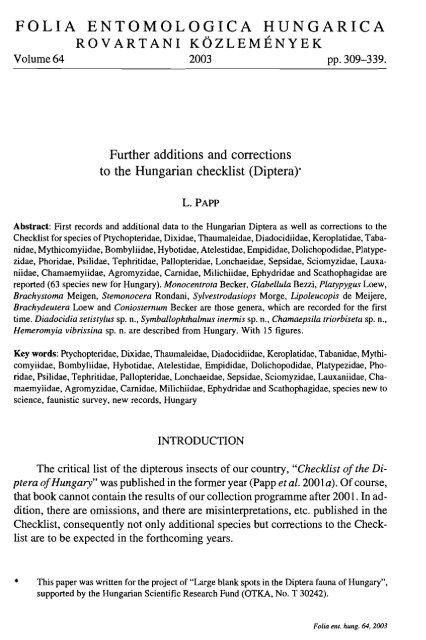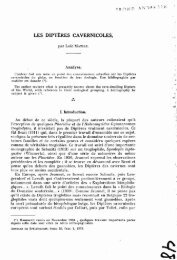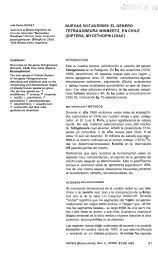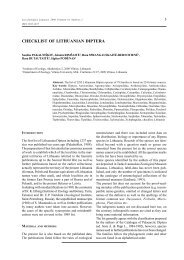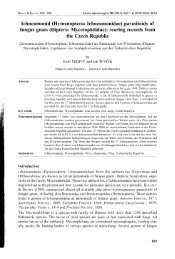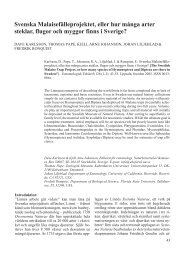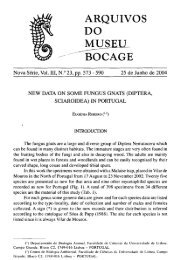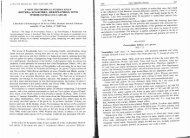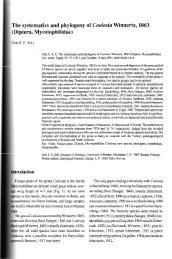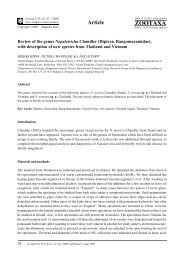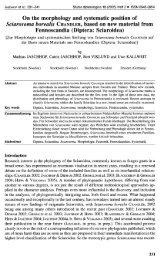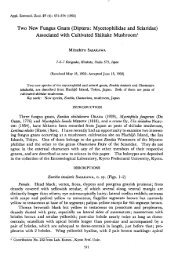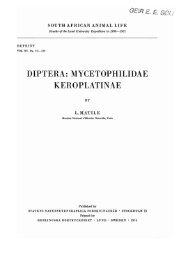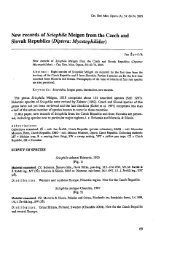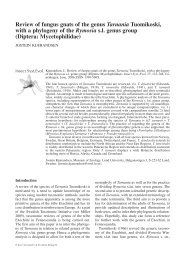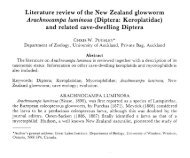FOLIA ENTOMOLOGICA HUNGARICA - Online Identification Keys
FOLIA ENTOMOLOGICA HUNGARICA - Online Identification Keys
FOLIA ENTOMOLOGICA HUNGARICA - Online Identification Keys
Create successful ePaper yourself
Turn your PDF publications into a flip-book with our unique Google optimized e-Paper software.
<strong>FOLIA</strong> <strong>ENTOMOLOGICA</strong> <strong>HUNGARICA</strong><br />
ROVARTANI KOZLEMENYEK<br />
Volume 64 2003 pp. 309-339.<br />
Further additions and corrections<br />
to the Hungarian checklist (Diptera)'<br />
Abstract: First records and additional data to the Hungarian Diptera as well as corrections to the<br />
Checklist for species of Ptychopteridae, Dixidae, Thaumaleidae. Diadocidiidae, Keroplatidae, Taba-<br />
nidae, Mythicomyiidae, Bombyliidae, Hybotidae, Atelestidae. Empididae, Dolichopodidae, Platype-<br />
zidae, Phoridae, Psilidae, Tephritidae, Pallopteridae, Lonchaeidae, Sepsidae, Sciomyzidae, Lauxa-<br />
niidae, Chamaemyiidae, Agromyzidae, Carnidae, Milichiidae, Ephydridae and Scathophagidae are<br />
reported (63 species new for Hungary). Monocenrrora Becker. Glabellula Bezzi, Platypygus Loew,<br />
Brachystorna Meigen, Stemonocera Rondani, Sylvestrodasiops Morge, Lipoleucopis de Meijere,<br />
Brachydeutera Loew and Coniosternum Becker are those genera, which are recorded for the first<br />
time. Diadocidia setistylus sp. n., Symballophthalmus inennis sp. n., Charnaepsila rriorbisera sp. n.,<br />
Hemeromyia vibrissina sp. n. are described from Hungary. With 15 figures.<br />
Key words: Ptychopteridae, Dixidae, Thaumaleidae, Diadocidiidae, Keroplatidae, Tabanidae, Mythi-<br />
comyiidae, Bombyliidae, Hybotidae, Atelestidae, Empididae, Dolichopodidae, Platypezidae, Pho-<br />
ridae, Psilidae, Tephritidae, Pallopteridae, Lonchaeidae, Sepsidae, Sciomyzidae, Lauxaniidae, Cha-<br />
maemyiidae, Agromyzidae, Carnidae, Milichiidae, Ephydridae and Scathophagidae, species new to<br />
science, faunistic survey. new records, Hungary<br />
INTRODUCTION<br />
The critical list of the dipterous insects of our country, "Checklist of the Diptera<br />
of Hungary" was published in the former year (Papp et al. 2001~). Of course,<br />
that book cannot contain the results of our collection programme after 2001. In addition,<br />
there are omissions, and there are misinterpretations, etc. published in the<br />
Checklist, consequently not only additional species but corrections to the Checklist<br />
are to be expected in the forthcoming years.<br />
* This paper was written for the project of "Large blank spots in the Diptera fauna of Hungary",<br />
supported by the Hungarian Scientific Research Fund (OTKA, No. T 30242).<br />
Folia ent. hung. 64, 2003
3 10 L. Papp<br />
Since 2002 was the closing year of our four-year faunistic project, some spec-<br />
imens, which had not been identified formerly, were also studied. In addition, new<br />
data on rare or interesting species recorded as new for our fauna in earlier papers,<br />
are provided.<br />
All the specimens below are deposited in the Diptera collection of the Depart-<br />
ment of Zoology, Hungarian Natural History Museum, Budapest (below: HNHM).<br />
The list of the abbreviations and translations of the Hungarian words on labels<br />
were published in the former papers for the project "Large blank spots in the Di-<br />
ptera fauna of Hungary". In those cases, when the name of the collector is not<br />
given, the specimens were collected by Lisz16 Papp. Handwritten texts are given<br />
in quotation marks. Additional information not given on labels (incl. English trans-<br />
lation of Hungarian words) are printed here in square brackets.<br />
PTYCHOPTERIDAE<br />
Ptychoptera agnes Krzemiliski et Zwick, 1993 -It was described from Dobog6kG (Hungary)<br />
(Krzemiliski & Zwick 1993) but it was omitted from the Checklist (Papp 2001~). I cannot find any<br />
excuse for me, but it might be some explanation only, that the type specimen is not deposited in the<br />
HNHM and I simply did not know the original paper.<br />
Dixella filicornis (Edwards, 1926) - 7 males: drskgi NP: SzGce, Kovicsszer, SzGce-p. folott<br />
6s mellett, 2002.07.17. - This is a surprise (new to our fauna): the species were only known from<br />
Great Britain, France, Yugoslavia and some north and central parts of the former Soviet Union. This<br />
is the ninth known dixid species in the Hungarian fauna.<br />
This is probably the dipterous family, whose collection in the HNHM was<br />
most developed during the four-year faunistic survey. Prior to 1997 there were<br />
only four specimens of Th. bezzii in the collection of the HNHM from the<br />
Carpathian Basin (see Papp & Majer 2000), a pair from Mehidia (Romania), one<br />
from KBszeg and one from Miskolc, Garadna valley, captured in 1981 (misprinted<br />
as 1991 in Papp & Majer 2000: 238). Now there are 3 12 specimens of five species<br />
here. We (Papp & Majer 2000) published specimens captured in 1999 (and three in<br />
1997) only. Below label data of two species are given only, but all the known<br />
thaumaleid localities in Hungary are summarised in a table. As a result of our sur-<br />
Folio enr. hung. 64, 2003
Further additions and corrections to the Hungarian checklist (Diptera) 311<br />
vey we may declare: in the future, thaumaleids may play an important role as bio-<br />
indicators in our country: their presence in itself indicates "true mountain brooks",<br />
which are habitats for hundreds of species of Dixidae, Hybotidae, Empididae, etc.,<br />
which live exclusively there.<br />
Protected areas, localities Thaumalea species -<br />
T.a. T.r. T.b. T.t T.th.<br />
ZemplCni TK<br />
RegCc, ordog-volgy + + +<br />
RegkcNagyhuta, Vajda-v., Kemence-p. felsd folyfisa + + +<br />
FiizCr, Alsb-patak + +<br />
FiizCr, LBszl6-tanya alatt, Ifip kifoly6<br />
Bilkki NP<br />
Miskolc, Sebes-viz, ill. Garadna-patak<br />
Duna-Ipoly NP<br />
Di6sjen6, Kemence-p. fels6 folyisa<br />
Szokolya, SzCn-p. felsd folyisa<br />
Kdszegi TK<br />
Kdszeg, Httforris kifoly6ja<br />
Kdszeg, HBrmas-patak<br />
Velem, Hosszd-v., Szerdahelyi-p. felsd folyhsa<br />
Aggteleki NP<br />
Aggtelek, Lizina-patak<br />
p- +<br />
T. a.: Th. aperta Martinovsky et RozkoSnj; T. r.: Th. remota Martinovsky et RozkoSny (Carpathian<br />
species); T. b.: Th. bezzii Edwards (widely distributed); T, t.: Th. testacea RuthC; T. th.: Th.<br />
thalhammeri Zilahi-Sebess (alpine/W European species)<br />
Thaumalea testacea (RuthC, 183 1) - 2 females: KBszegi TK: KBszeg, Harmas-p. folott 6s<br />
mellett, 2001.06.27128. - The genitalia agree completely with the figures of Martinovsky & Roz-<br />
koiny (1976). As Prof Dr Riidiger Wagner wrote in one of his letters: "... I saw T. testacea from<br />
Slowenia and probably it may occur in your country". Papp & Majer (2000) regarded it as a species<br />
Folrn en!. hung. 64. 2003
312 L. Papp<br />
expected to occur in Hungary but they did not accept Zilahi-Sebess's (1960) record as valid. So I re-<br />
gard this species new to Hungary.<br />
Thaumalea thalhammeri Zilahi-Sebess, 1956 - 2 males: PCcs, figer-volgy, patak folott,<br />
2001.06.01; 1 male: Melegmlny TT: PCcs, Melegmdnyi-volgy, 2002. mljus 3 1, patak folott Cs<br />
mellett; 1 male: KBszegi TK: KBszeg, HCtforrls, patak folott, 2002.06.29. -It was a good surprise to<br />
find this mysterious species very near to its type locality again in 2001 (see Papp 2001a: 90). While I<br />
am sure of the identity of this species (Zilahi-Sebess's figures are informative enough to think so), we<br />
are afraid, we have to insist on all our statements about Thalhammer's thaumaleids (Papp & Majer<br />
2000), i.e. none of Zilahi-Sebess's records are acceptable as valid for the Hungarian species, and it is<br />
not sure that the holotype of Th. thalhammeri was really collected at PCcs.<br />
Diadocidia setistylus sp. n.<br />
(Figs 1-3)<br />
Holotype - Male (HNHM, flagellomeres L 3- and R 4- lost, most of mesoscutal and scutellar<br />
setae broken off): Kelet-Mecsek TK: Mecseknldasd, 2002.05.28, Varasdi-patak folott Cs mellett,<br />
leg. Papp L.<br />
Paratypes: 1 female (HNHM, only right flagellomeres 12-14 lost): Melegmdny[i-volgy] TT,<br />
PCcs, Melegmdnyi-v., patak mellett, 2002.05.29, leg. Papp L.; 1 male (HNHM, wings kept dry be-<br />
tween two small pieces of cover glass in a round hole in a cardbord label used for double-mounting,<br />
apical half of abdomen with genitalia are in a plastic microvial with glycerol, body and legs (broken)<br />
in a glass microvial with glycerol): Kelet-Mecsek TK, Obdnya, bbhyakpatak folott, mellett,<br />
200 1.05.28, Papp L.<br />
Measurements (in mm): body length 2.70 (holotype), 2.94 (paratype female),<br />
wing length 3.00 (holotype), 3.08 (paratype male) and 3.80 (paratype female),<br />
wing breadth 1.20, 1.30 and ca. 1.4.<br />
Head and body brown, legs yellow, at most light brownish yellow.<br />
Lateral ocelli more than twice larger than median one, and separated from the<br />
eye margin by a distance of about 113 of their diameter. Scape and pedicel yellow-<br />
ish, as long as wide, with dark setae. Flagellum of 14 flagellomeres, dark brown,<br />
cylindrical, densely covered with fine pale cilia, tapering towards apex. Base of<br />
first flagellomere yellowish. Ratio of length of flagellomeres 1 to 3 18: 10:10, i.e.<br />
0.20 and 0.1 1 mm, width of flagellomere 1 0.05 mm, that of flagellomeres 2-3<br />
0.04 mm. Mouthparts and palpi brownish yellow. Four palpomeres, covered with<br />
lighter brown setae. Apical palpomere thin and long, only 0.17 mm long on holo-<br />
type (dry), 0.33 rnrn on paratype male.<br />
Mesoscutum uniformly dark brown, shiny, with some bluish grey micro-<br />
tomentum, but without longitudinal stripes. Lateral margins of mesoscutum with<br />
long setae. Scutellum with several long dark apical bristles, some of them twice as<br />
Folio cnr hung. 64, 2003
Further additions and corrections to the Hungarian checklist (Diptera) 313<br />
Figs 1-3. Diadocidia setisrylus sp. n., paratype male, genitalia - 1: cerci and right half of genitalia,<br />
dorsal view; 2: gonostylus in widest extension, in caudal view; 3: tergite 9 ventrally. Scale: 0.1 mm<br />
for all<br />
Folia enl. hung. 64. 2003
3 14 L. Papp<br />
long as scutellum. Anepisternum, preepistemum 2 and metepisternum lighter brown,<br />
metanotum and laterotergite as dark as mesoscutum. Antepronotum with several<br />
long setae, longest one 0.3 1 mm. No anepisternal setae.<br />
Wings light brownish, veins light brown, both membrane and veins evenly<br />
covered with macrotrichia. Costa produced beyond R, by a distance of 0.14 mm.<br />
Sc strong, H to Sc per Sc to R, distance of costa 59233. R, ending in C at the level of<br />
base of M-fork. Cross-veins R-M and M-M in one line. M ratios: 51:114 and<br />
51:91, Cu, ratio 70:66. h.13 thick to wing margin, Cu, distinct to level of M3-Cu. A,<br />
well developed and setose, reaching wing margin. Calypter with several long setae<br />
along its margin, up to 0.23 mm. Halteres brown, but yellowish white in basal third.<br />
Legs yellow, covered with evenly set dark trichia and several setae. Male hind<br />
coxa in middle third with four black setae of 0.2 mm posterolaterally. All trochan-<br />
ters with a black spot ventrally. Femora laterally slightly compressed and thickened<br />
medially. Ratios of coxae to femora (without trochanter) and to tibia: 49231: 104;<br />
49:85: 1 18; 50: 1 1 1 : 157. Mid tibia with two anterodorsal and three posterodorsal<br />
setae. Hind tibia with three long dorsal setae. All spurs on mid and hind tibiae<br />
subequal in length, hind ones 0.21 mm (measurements taken on holotype). Em-<br />
podia very small.<br />
Abdomen dark brown, tergites and sternites covered with long dark setae.<br />
Male terminalia (Figs 1-2) 0.28 mm long. Gonocoxites not large, but seem robust<br />
(Fig. l), meeting on a longer section ventrally. Gonostylus broad at base, horizon-<br />
tally medially curved, with high number of strong setae. The apex of gonostylus is<br />
comparatively thick, black and not bifid (Figs 1-2); gonostylus in broadest exten-<br />
sion (largely in a caudal view, Fig. 2) subtriangular. Aedeagus rather simple, ven-<br />
trally curved. Tergite 9 (Fig. 3) rather small (cf. bar), transverse, i.e. 2.85 times<br />
broader than long, with long thick setae on all its caudal 314.<br />
Female similar to male (female paratype with two lighter mesoscutal lines but<br />
they are probably due to its slightly teneral status), cerci ochre with brown apex.<br />
Fore leg with tarsomeres 2 to 4 hardly swollen, tarsomere 1 being far the thickest.<br />
All fore tarsus and mainly ventral half of mid tarsus covered with thick dense black<br />
setulae. Length ratio of fore tarsomeres 69:30:22: 14: 12. The ratio of length to the<br />
maximum width of the fore tarsomere 2 is 6.0 (in comparison, this ratio is ca. 3.5 in<br />
D. ferruginosa). Cx, with 7 long but less even setae.<br />
Etymology -The specific epithet "setistylus" (noun) refers to the armature of its male gono-<br />
stylus.<br />
This is a peculiar species with its uniapical and strongly setose gonostylus and<br />
transverse male tergite 9, and female fore tarsomeres 2-4 not swollen. It is easily<br />
recognisable by its unicolorous (not striped) dark thoracic scutum. I think, there is<br />
Folin en[. hung. 64. 2003
Further additions and corrections to the Hungarian checklist (Diptera) 315<br />
no closely related species in the Holarctic, but I have found a similar Diadocidia<br />
species in Taiwan, which will be described in the near future.<br />
Monocentrota matilei Bechev, 1989 (Figs 4-8) - 2 females: VerBce, Magyarklit, Keskeny-<br />
biikki-p. v., patak mellett, 2002.06.22, leg. Papp L.; 2 males, 4 females: ibid., 06.27,20-22 h. -The<br />
genus and species are new to Hungary. In order to aid identification, I prepared and depicted the geni-<br />
talia of one male specimen (c.f. Bechev 1989).<br />
Figs 4-8. Monocentrota rnatilei Bechev, 1989, male genitalia - 4: genital tergite and cerci in ventral<br />
view; 5: genitalia, dorsal view; 6: gonostylus in broadest extension (subcaudal view); 7: aedeagus in<br />
dorsal view; 8: aedeagus in lateral view. Scales: 0.2 mm for Figs 4-5 and 7-8,O.l mm for Fig 6<br />
Folia en?. hung. 64, 2003
316 L. Papp<br />
Chrysops sepulchralis (Fabricius, 1794) - 3 males: Zempl6ni TK, Nagyhuta, KBkapu, viri-<br />
gokr61,2002. jlil.04.105. Szappanos A. -Though it had for long been expected to occur in the modem<br />
Hungary (Majer 1987). these are the first voucher specimens from our country.<br />
Empidideicus hungaricus Thalhammer, 191 1 - It was described from Vasklit, but the type<br />
specimens were annihilated in the HNHM in 1956. One female was collected in the nineties but we<br />
(A. Szappanos and L. Papp) captured (on small flowers, like Gypsophila) more than 1000 specimens<br />
in the last two years, of which 406 males and females were minuten pinned and preserved in the<br />
HNHM from Budapest, Pestszentldrinc (PCterhalmi-erdB), CsCvharaszt, KecskemCt (Borbk,<br />
Matk6), NyklBrinc, HetCnyegyhBza, FiilophBza and Kerekegyhiza.<br />
Glabellula arctica (Zetterstedt, 1838) - 1 male: ZemplCni TK: Nagyhuta, KBkapu, virigokr61,<br />
2002. jlil. 5.. Szappanos A. & Papp L. -The genus and the species are new for the Hungarian fauna.<br />
Platypygus bellus hew, 1873 - 1 male: KecskemCt, Borbis, 2002.06.15, fityolvirBgr61, leg.<br />
Szappanos. -The genus and the species are new for the Hungarian fauna. Actually I do not know any<br />
record of the genus Plarypygus from the Carpathian Basin. However, at least P. ridibundus (A. Costa,<br />
1863), a widely distributed Mediterraneas species, is expected to occur.<br />
Apolysis sp. n. - 1 male: 2001.05.21, KerekegyhBza, nagyerdd, hB16zva [large forest, sweep<br />
netted], leg. Szappanos A. (genitalia are preserved in a plastic microvial with glycerol); 1 female:<br />
Fiilophiza, 2002.06.19, KNP [Kiskunsig National Park], fBtyolvirigr61 [on flowering Gypsophila],<br />
leg. Szappanos A. -They were studied in detail (it is really a new species with M-M cross-vein) but it<br />
is not described as new here.<br />
In Hungary Thalhammer (1900) recorded A. eremophila h ew from Kalocsa (also his hand-<br />
written collection catalogue contains this locality). T6th (1977) in his Bombyliidae part of the Fauna<br />
Hungariae gave Deliblat (Yugoslavia, Vojvodina) as the only known locality in the Carpathian Ba-<br />
sin. He gave the name in square brackets, which means that the species had not been recorded in Hun-<br />
gary but it was expected to occur. In the "Checklist of the Diptera of Hungary" (T6th in Papp et al.<br />
2001) gave its entry in a rather unfortunate way: "Thalhammer 1900: 29 (Kalocsa, QR, A56). T6th<br />
1977b: 12". It is true that Kalocsa was a published record, but that is a questionable record and the<br />
voucher specimen(s) waslwere annihilated in the fire in the HNHM in 1956. The second part of the<br />
entry refers to its Fauna Hungariae work, but in the given way it means the first reliable record from<br />
Hungary. I am afraid that A. eremophila is indeed a Middle Asian species and all its European and<br />
North African records would need a revision1corroboration. In addition, one cannot definitely know<br />
anything on Thalhammer's record (even the generic relegation seems questionable). Consequently,<br />
we propose to delete A. eremophila Loew, 1973 from the Hungarian list.<br />
Folia ent. hung. 64, 2003
Further additions and corrections to the Hungarian checklist (Diptera) 317<br />
Chersodromia cursitans (Zetterstedt, 1819) - 1 male, 2 females: Balatonakali, parti nhdas,<br />
2002. aug. 15116. -In his Fauna Hungariae book WCber (1975) keyed five species expected to occur<br />
in Hungary (no species actually recorded). Later he (WCber 1987) published Ch. arenaria (Haliday,<br />
1833) from the Kiskunsigi NP. Those voucher specimens are still preserved in the HNHM. Foldvhri<br />
(2001) quoted WCber's (1987) record correctly. Now also those specimens (4 males, 4 females:<br />
Kiskunsigi NP, Kerekegyhhza, Kondor-tb, t6szegBly, 1979.VI.5, leg. Papp L.) were revised. They all<br />
belong to Ch. cursitans. I cannot understand that mistake. WCber prepared the male genitalia, which<br />
show clearly features of Ch. cursitans and strongly different from those of Ch. arenaria (see Chvhla<br />
1975: fig. 644-646, cf. 650-652). In addition, WBber possessed (on loan) a pair of true C. arenaria<br />
from Hejls (Denmark), which the HNHM received as a gift from the Copenhagen Museum (Lund-<br />
beck's Collection). So C. cursitans is a species new for the Hungarian fauna and C. arenaria (Hali-<br />
day, 1833) is proposed to be deleted from the Hungarian list.<br />
Drapetis (Drapetis) sp. n. - 2 males, 1 female: Budapest, Pestszentldrinc, PBterhalmi-erdd.<br />
tolgyes ltolgyes, tisztisok, 2002.05.14.118-20.125-26. -This is a species in the D. incornpleta group<br />
(cross-veins close together, wings evenly but strongly darkened, setae ventrally on pedicel very short,<br />
vein R,,, abbreviated, not reaching wing margin). However, since male genitalia are different from<br />
those of D. incornpleta Collin, 1926 or D. furnipennis Strobl, 1906 (Spain), this is probably a new (un-<br />
described) species.<br />
Dysaletria atriceps (Boheman, 1852) - 1 male: Balatonakali, parti nidas, 2002.07.16; 1 male,<br />
1 female: BalatonfelvidCki NP: Tihany, Kiilsd-tb, 2002. aug. 16. -This is a rare species new to Hun-<br />
gary (formerly known from N Europe, incl. Russia, from Poland and Germany) (Chvila & Kovalev<br />
1989).<br />
Dysaletria nigripennis Chvhla, 1975 - 1 female: dcsai TK: dcsa, Nagy-erdd.2002.05.11; 2<br />
males, 1 female: Budapest, Pestszentldrinc, PCterhalmi-erd6, tolgyes, 2003.05.10-1 1. - It was pub-<br />
lished from Hungary very recently (Papp & Foldvfiri 2002). based on a pair of specimens from the<br />
Ptterhalmi forest.<br />
Euthyneura inermis (Becker, 1910) - 3 males, 2 females: K-Mecsek TK: Obinya, 6binyai-<br />
volgy, patak folottfMalaise-csapda, 1999. mhjus 25130,2001.05.28; 1 female: Mecsek-hegys., [PCcs]<br />
Vasas 11.. fcs, 1966.IV.21, Dr WCber; 1 male: Melegminyi TT: PCcs, Melegmhnyi-volgy, 2001.<br />
05.29, patak folott, mellett; 3 males, 1 female: Duna-Ipoly NP: Szokolya, SzCn-p. folott 6s mellett,<br />
2000. mhjus 13, 1 female: ibid., Vasfazkk-volgy, 1996.V.14; 1 male: Jbsvafd, erdd, 1963.VI.4, leg.<br />
Mihilyi; 5 males, 1 female: Budapest, Pestszentldrinc, PCterhalmi-erdd, erdei tiszths/tolgyes, 2001.<br />
04.29-301 mhjus 131 05.19-201 2003.05.10-1 1; 1 female: Gint, Koves-v., 1961.V. 11, leg. So6s A.; 1<br />
female: Gint, Fhni-volgy, 1997.V. 14, leg. Papp L. & Adam L. -This is a species new for the Hungar-<br />
ian fauna. Three specimens were published as E. rnyrtilli (see below), the others were collected in the<br />
frame of our faunistic survey.<br />
Euthyneura rnyrtilli Macquart, 1836 - 1 male, 1 female: Budapest, Pestszentldrinc, Halmi-<br />
erdd, tolgyes, avarszint, 2000. iprilis 29-30lmhjus 7. - These specimens are the first true voucher<br />
specimens for its occurrence in Hungary. All the four specimens published by WCber (1975) were<br />
misidentified. Three of them belong to E. inermis (see above), the fourth one, a female (published as<br />
male) from Slovakia (Dobsina, Vasut hll., 1964.VII.23, Horvatovich, Euthyneura rnyrtilli Macq., det<br />
WCber) may belong to an undescribed species (with extremely long proboscis). Unfortunately it is se-<br />
riously damaged. E. rnyrtilli was first published by WCber (1966) as E. sirnillirna Strobl. So both the<br />
records are based on misidentifications.<br />
Megagrapha europaea Papp et Foldviri, 2002 - 9+ 1 males, 1 female: Kdszegi TK: Kdszeg,<br />
Hhrmas-p. folott Cs mellett, 2001.06.27.12002. jlil. 10; 1 female: ibid., HCtforris, patak folott, 2002.<br />
Folia ent. hung. 64,2003
318 L. Papp<br />
jdl. 10; 3 males: ZemplCni TK: RegCc, Ordog-v., patak folott Cs mellett, 2001. junius 13.12002.07.04,<br />
leg. Papp L. Cs Szappanos A.IPapp L.; 1 female: ibid., Vajda-volgy, Kemence-pat& folott Cs mellett,<br />
2001.06.15.; 1 male: Biikki NP: ~massa, Garadna-p. fels6 folylsa folott Cs mellett, 2001.06.16.; 1 female:<br />
Kelet-Mecsek TK: Obinya, Obinyai-patak folott, mellett, 2001.05.29.; 1 male, 1 female:<br />
Melegminyi-volgy lT: PCcs, MelegmAnyi-volgy, patak folott Cs mellett, 2001.05.29.12002. mijus<br />
31. It was described from the Kelet-Mecsek TK (Koml6, Zob&kpuszta, Hidasi-volgy and Obinya)<br />
and from the ZemplCni TK, RegCc, Ordog-volgy. -The other localities above are new occurrences.<br />
Oedalea tibialis Macquart, 1827 - 1 male: ANP: Aggtelek, Lizina-patak folott Cs mellett,<br />
2002. $1.06. -Another species new for the Hungarian fauna. WCber (1975) listed and keyed it as a<br />
species expected to occur.<br />
Symballophthalmus fuscitarsis (Zetterstedt, 1859) - 1 male, 1 female: Kelet-Mecsek TK:<br />
MecseknAdasd, 2002.04.28, Varasdi-pat& folott Cs mellett, leg. Papp L.; 1 male, 1 female: OCS~~TK,<br />
~csa, Nagy-erd6,2002.05.11. -New to Hungary. This is the third species of Symballophthalmus in<br />
Hungary, whose occurrence was also expected (Papp & Foldviri 2000).<br />
Symballophthalmus inermis sp. n.<br />
(Figs 9-12)<br />
Holotype - Male (HNHM): Kelet-Mecsek TK: Mecseknidasd, 2002.04.28, Varasdi-patak<br />
folott Cs mellett, leg. Papp L.<br />
Measurements (in mm): body length 2.45 (together with abdomen prepared,<br />
now kept in a plastic microvial with glycerol), wing length 3.05, wing breadth ca.<br />
1 .OO (slightly wrinkled).<br />
Slender species with densely microtomentose mesonotum. Body black, legs<br />
yellow but tarsomeres 2-5 of fore leg and all tarsi but metatarsus of mid leg grey<br />
infuscated and whole hind tibia and tarsi infuscated.<br />
Head inserted to a distinct "neck" of prothorax. Eyes bare, touching and con-<br />
tiguous on a long section on frons, widely separated on face. Facettes much larger<br />
dorsally than ventrally. Three ocelli on a tubercle exactly on vertex. One pair of<br />
medium-long ocellar setae, but ocellars fine (thin), some similar-hairlike setae on<br />
occiput. Two pairs of vertical setae and a postocellar pair can be separated, though<br />
with much attention. In profile, antennae inserted slightly below middle of head.<br />
Scape minute, first flagellomere laterally flattened, long, its length : breath ratio<br />
17 : 5 = 3.4, i.e. 0.19 mm long and 0.056 mm broad (broadest subbasally). In pro-<br />
file, dorsal margin of first flagellomere straight, ventral margin convex, ventrally<br />
with 0.02mm long fine cilia. Arista rather thick but extremely short, i.e. 0.13 mm<br />
long only, finely pubescent. Palpi minute and narrow, covered by long setiform<br />
hairs. Proboscis withdrawn into the head on holotype but certainly shorter than 112<br />
length of vertical height of head.<br />
Folia ent. hwg. 64. 2003
Further additions and corrections to the Hungarian checklist (Diptera) 3 19<br />
Thorax comparatively long and narrow, only slightly humped. Postpronotal<br />
lobe though small, well differentiated. Mesonotum covered with very dense light<br />
microtomentum, even thicker than in S. pictipes, and covered with dense short pale<br />
hairs. Four pairs of rather long but thin yellow scutellars. Acrostichal setae fine,<br />
comparatively short and biserial. Dorsocentral hairs hardly discernible among<br />
other mesonotal hairs. Anepisternum, katepisternum and meron mainly shiny black.<br />
Wings clear, large, narrow at base, broadening towards tip, apical part broadly<br />
rounded. No anal lobe. Veins ochre. Vein R, ends in costa distinctly distally to<br />
middle of wing. Costa thickened on section mg,. Vein R4+, archely curved and ter-<br />
minates at wing tip. Veins R4+, and M not parallel on a long section, almost so at<br />
apical part. Basal cells long, cross-veins meet at one point of M. Anal cell present,<br />
but small with an acute-angled upper edge. Anal vein faint but long. Squamae and<br />
halteres whitish yellow.<br />
All legs, incl. femora equally slender, without any modifications or peculiar<br />
armature. Fore metatarsus without long pale hairs anteroventrally, i.e. hairs there<br />
shorter than metatarsal diameter. Legs mainly yellow. Only apical third of hind fe-<br />
mur slightly brown darkened. Fore and mid tarsi, except for metatarsi, second fore<br />
tarsomere and entire hind tarsi dark grey infuscated, as well as whole hind tibia.<br />
Distal tip of yellow tarsomeres darkened. Mid femur ventrally with two rows of<br />
rather short black thornlets.<br />
Abdominal sclerites weakly sclerotized, male genitalia not particularly large,<br />
whole genitalia turned upwards. Cerci large and long (as usual in this genus), right<br />
cercus (Figs 9-10) shorter than in S. asiaticus and its apical part less curved, left cer-<br />
cus (Figs 10-1 1) rather simple and broad. Surstylar lamellae comparatively small<br />
(Figs 9-12), right lamella slender (at least much narrower than that of S. asiaticus),<br />
its basal process shorter and rounded apically (Fig. 9). Left lamella (Figs 1 1-1 2)<br />
short, bipartite, apical process conspicuously bifid; as for its basic structure, similar<br />
to that of S. asiaticus (cf. Kovalev 1977: Fig. 4), but distinctly different in details.<br />
Female not known.<br />
Etymology - The Latin specific epithet "inermis" means unarmed, which refers to the absence<br />
of long anteroventral hairs on male fore metatarsus.<br />
S. inermis sp. n. is probably closest to S. asiaticus Kovalev, 1977, which was<br />
described from Mongolia. Also the mesonotum of that species is densely micro-<br />
tomentose and it possesses shorter brown anteroventral hairs on male fore meta-<br />
tarsus but all its tarsi are darkened. Details of male genitalia are distinctly different<br />
(Kovalev 1977: Figs 1-4). In all probability S. asiaticus is not smaller (wing length<br />
is almost the same) but the abdomen of its types were more shrivelled. In contrast<br />
Folia enr. hrmg. 64. 2003
3 20 L. Papp<br />
Figs 9-12. Syrnbnllophthalmus inermis sp, n., holotype male, genitalia - 9: right lamella and cerci,<br />
right lateral view; 10: epandrium and cerci with right lamella, dorsal (perpendicular to cerci) view;<br />
11: cerci and lamellae, left lateral view; 12: left lamella, lateral view. Scales: 0.2 mm for Figs 9-11,<br />
0.1 mm for Fig. 12
Further additions and corrections to the Hungarian checklist (Diptera) 321<br />
to this new species, where arista is distincly shorter than first flagellomere, arista of<br />
S. asiaticus is 1.35-1.45 times longer than first flagellomere.<br />
Symballophthalmus pictipes (Becker, 1889)- 1 male: OrfG, Szuad6-v., szurdok, 2001.06.3 1;<br />
1 male: Kelet-Mecsek TK, Obhnya: Obhnyai-patak folott, mellett, 2001.05.28; 3 males: ZemplCni<br />
TK, RegCc: Ordog-v., patak folott, mellett, 2001. jlinius 13, leg. Papp L. and Szappanos A.; 1 female:<br />
Biikki NP: Miskolc. Sebes-viz p. folott 6s mellett, 2002.06.19; 1 female: ANP: Aggtelek, MCnes-<br />
volgy, patak Tolott Cs mellett, 2002. jlil. 07. - See more in Papp & Foldvfiri (2000).<br />
Tachypeza fennica Tuomikoski, 1932 - It was reported from Hungary based on a single male<br />
(Papp & Foldvki 2002). In 2001 other nine specimens were captured: 5 males: ZemplCni TK: RegCc,<br />
Ordog-v., patak folott, mellett, korhadb bUkkfatorzsekr61, jlinius 13.114, leg. Papp L. Cs Szappanos<br />
A.; 1 male: ibid., Malaise-csapda patak mellett, jlinius 14; 1 male: ibid., Vajda-volgy, 06.14, Kemen-<br />
ce-patak hidja alatt; 2 females: BNP: Miskolc, Sebes-viz p. folott Cs mellett, 06.16.<br />
Tachydromia edenensis Hewitt et Chvila, 2002 - 2 males, 4 females: Duna-DrBva NP, 6r-<br />
tilos, kavicszhtony, bhnyatavak mellett, 2002. mhjus 30. -This species was described most recently<br />
from England (Hewitt & Chvila 2002). of course, it is new to Hungary. It is worth mentioning that the<br />
specimens were captured in the same habitat as the types: the Hungarian word "kavicszhtony" means<br />
gravel shallow.<br />
ATELESTIDAE<br />
Meghyperus sudeticus Loew, 1850 - 1 female: Duna-Driva NP: BClavhr, Drhva irteriilet,<br />
bhyatavak mellett, 2002. mAjus 30; 1 female: ZemplCni TK: Nagyhuta, Seny6-volgy, patak folott Cs<br />
mellett, 1999. jlinius 9, leg. Papp Lhszlb, Szappanos Albert; 1 female: N6grAdszakil. Rir6spuszta,<br />
Ipoly partjhn [on the bank of river Ipoly], 2003. mhjus 27. -This is a rare species with little known<br />
habits (formerly four specimens were only reported from the Bakony and the Bukk Mts). All these<br />
specimens were captured near water flows (brooks and rivers).<br />
Nemedina alamirabilis Chandler, 198 1 - 1 male, 4 females: Melegminy T T PCcs, Melegmh-<br />
nyi-volgy, 2002. mhjus 31, patak folott Cs mellett, leg. Papp L. -This species was formerly known<br />
from the single holotype female. The analysis of the male genitalia, etc. will be given in a separate paper.<br />
Chelifera flavella (Zetterstedt, 1838) - 5 males, 1 female : BNP: Miskolc, Sebes-viz p. folott<br />
6s mellett, 2001.06.16./2002.06.19; 2 males, 1 female: ZemplCni TK, RegCc, Vajda-volgy, Kemen-<br />
ce-patak folott Cs mellett, 1999. jlinius 28.12001.06.15. -These nine specimens were found as an ad-<br />
dition to those four, which were reported by Papp & FoldvAri (2002). It is rather rare in our country<br />
compared to Ch. trapezina (Zetterstedt, 1838).<br />
Chelifera trapezina Collin, 1927 -In the last three years, i.e. after its first record from Hun-<br />
gary, 298 males and 168 females (June 19 to Aug 3) were captured and preserved from the following<br />
localities: K6szegi TK: K6szeg (Himas-p., HCtforris), Velem (Hosszli-v.); ZemplCni TK: RegCc<br />
(Ordog-v., Vajda-v., Kemence-p. fels6 folyisa); Biikki NP: Miskolc (Sebes-viz); Duna-Ipoly NP:<br />
Szokolya (Sztn-p.). Di6sjen6 (Kemence-p. fels6 folyisa).<br />
Folia en!. hung. 64, 2003
Clinocera barbatula (Mik, 1880) - 5 males, 4 females: KBszegi TK: KBszeg, HttforrAs, patak<br />
folott, 2001.06.29./2002. jli1. 12; 1 male, 1 female: ibid., HArmas-patak folott Cs mellett, 2002. jhl. 1 1.<br />
-It was reported as new to Hungary (Papp & FoldvAri 2002) based on a single male from "HCtvezCrforrAs",<br />
i.e. hitherto known only from the KBszegi Mts in our country.<br />
Clinocera sp. nr barbatula - 1 male: MelegmAnyi-volgy 'IT PCcs, MelegmAnyi-volgy,<br />
2001.05.29, patak folott 6s mellett. - This is a species close to C. barbatula (stigma faint, R, very<br />
long, fore femur with apical medical comb, legs darker, cf. Collin 1961) but its surstylus is pointed<br />
apically with straight anterior edge.<br />
Clinocera wesmaeli (Macquart, 1835)- In the last three years 66 males and 59 females (April<br />
1 to Aug 3) were captured and preserved from the following localities: KBszegi TK: KBszeg (Hirmas-p.,<br />
HCtforris), Velem (Hosszh-v.); ZemplCni TK: Fiikr (Als6-p., LAszl6-tanya), RegCc (Ordog-v.,<br />
Vajda-v., Kemence-p. fels6 folyAsa); Biikki NP: Miskolc (Sebes-viz); Duna-Ipoly NP: Szokolya<br />
(SzCn-p.), Di6sjenB ( Kemence-p. fels6 folyAsa).<br />
Dolichocepha spp. -In 2001 and 2002 representatives of three species (other than the common<br />
D. irrorata) were collected in the frame of our faunistic survey. They are as follow: D. guttata<br />
(Haliday, 1833): 17 males, 8 females from Hetvehely (NyLis-p.), Kelet-Mecsek TK: 6binya (obinyai-p.),<br />
Kdszegi TK: KBszeg (Hfmas-p.); D. oblongopunctata (Dale, 1878) (recorded as D. engeli<br />
Niesololowski, 1992 by Papp & Foldvfiri (2002)): 2 males from ZemplCni TK, RegCc (Ordog-v.); D.<br />
ocellata (Costa, 1854): 1 male, 3 females from Melegminyi-volgy TT: PCcs (MelegmAnyi-v.) and<br />
Kelet-Mecsek TK: Obinya (Obinyai-p.).<br />
Gloma fuscipennis Meigen, 1822 - Papp & Foldviri (2000) recorded it first from Hungary<br />
based on four males captured in 1999. In the last three years (May 28 to June 28) 50 males and 6 females<br />
were captured at the following localities: K6szegi TK: Velem (Hosszh-v.), KBszeg (Hhas-p.,<br />
HCtforris), Kelet-Mecsek TK: Obinya (Obinyai-p.), Koml6, ZobAkpuszta (Hidasi-v.), Mecseknidasd<br />
(Varasdi-p.), Duna-Ipoly NP: Szokolya (SzCn-p.), Di6sjenB (Kemence-p. fels6 folyisa), Orfii<br />
(Szuad6-v.), Ptcs (Eger-v.. Melegminyi-v.), FelsBvadisz.<br />
Hemerodromia joosti Wagner, 1984 - 1 male, 3 females: Szatmir-beregi TK: Kisar, Tisza<br />
irtere, 2001.07.12.; 1 male: Szeged: ~jsze~ed, Tisza-part, 1997.05.3 1, leg. Paulovics P. -These are<br />
the only known specimens other then the holotype.<br />
Brachystoma vesiculosum (Fabricius, 1794) - 1 male: Duna-Driva NP, BClavir, Driva<br />
Arteriilet, binyatavak mellett, 2002. mfjus 30. - This species represents not only a genus but a<br />
subfamily new for the Hungarian fauna.<br />
Tachytrechus notatus (Stannius, 1831) - 2 males: Balatonakali, parti nidas, 2002. aug. 15. -<br />
WCber (1989) keyed eight species of Tachytrechus in his book in Fauna Hungariae: three species<br />
with notes that although Thalhammer (1900) recorded them from localities of the present Hungary,<br />
no voucher specimens were preserved (or survived the 1956 fire), and five species in square brackets,<br />
incl. T. kowarzi Mik (i.e. as species expected to occur). Foldvan (2001) listed all those eight species<br />
but only T. kowarzi Mik, 1865 was without square brackets, since its type locality is Miskolc. I con-<br />
curred with that solution. In any case, these are the first Tachytrechus specimens from Hungary in the<br />
collection of the HNHM collected after 1956.<br />
Folia enr. hung. 64, 2003
Further additions and corrections to the Hungarian checklist (Diptera) 3 23<br />
Agathomyia wankowiczii (Schnabl, 1884) - 1 female: Ny-Mecsek: OrfG, Szuad6-v., szurdok,<br />
2002.05.3 1. - A rare species (known from most countries of the middle zones of Europe but very spo-<br />
radically) new for the Hungarian fauna.<br />
Megaselia xanthozona (Strobl, 1892) - 1 male: Budapest, Pestszentldrinc, PCterhalmi-erdB,<br />
tolgyes szCli virlgokr61, 2002.07.21. - This beautiful and comparatively easily identifiable species<br />
was first recorded from Hungary by Schmitz (1924). This is the first voucher specimen in the HNHM<br />
after the big fire in 1956.<br />
Triphleba smithi Disney, 1982 -45 males: BalatonfelvidCki NP: Tihany, Kiilsd-t6,2002. aug.<br />
16; 11 males: Balatonakali, parti nhdas, 2002. aug. 15; 2 males: ibid., aug. 11; 2 males: ibid., aug. 16.<br />
- A species new for the Hungarian fauna; Adim & Papp (1996) and Papp et al. (2001a) listed it as a<br />
species expected to occur in our country. All the specimens were captured (netted) in dense reeds or<br />
in sedges mixed with reed.<br />
Pseudopomyza atrimana (Meigen, 1830) - 1 male: Kdszegi TK: Veleln, Hosszu-volgy, Szer-<br />
dahelyi-p., foldi bodza virhgjlr61,2002. jul. 11; 1 female: Kdszeg, Hirmas-patak folott, 2000.07.25;<br />
1 male, 1 female: ZemplCni TK: Nagyhuta, KBkapu, virlgokr61, 2002. jlil. 5, Szappanos A. -It was<br />
reported from Hungary just prior to our four-year survey (from the drsCgi NP). It is important to<br />
know it from three other sites.<br />
Strongylophthalmyia ustulata (Zetterstedt, 1847) - 1 male, 3 females: Aggteleki NP: Aggte-<br />
lek, MCnes-volgy, patak folott 6s mellett, 2002. jlil. 7; 1 male, 1 female: VerBce, Magyarkut, Kes-<br />
kenybiikki-p., patak mellett, 2002. julius 24. -This family was reported from Hungary for the first<br />
time (Papp 2001b) based on a single female, which was captured at the same place as the above last<br />
two specimens.
3 24 L. Papp<br />
Chamaepsila triorbiseta sp. n.<br />
(Fig. 13)<br />
Holotype - Female (HNHM): Duna-Ipoly NP: Kemence, KirAlyhAza, Petasitetum, 2000.<br />
augusztus 1, leg. Papp L.<br />
Measurements (in mm): body length 3.44, wing length 3.26, wing breadth<br />
1.52.<br />
Most of the head and all thorax shiny yellow, abdomen bright black.<br />
Frons bright reddish yellow with a broad black anterior part but supralunular<br />
area also reddish yellow in the form of a triangle. Head with 3 vertical pairs, ocellar<br />
and postocellar pairs strong (both widely divergent), 3 medium-long fronto-orbital<br />
pairs of setae (Fig. 13). Genae broad, below eye 0.36 mm, height of eye 0.59 mrn.<br />
First flagellomere deep black. Arista 0.57 mm long. Palpi short, comparatively<br />
thin, black; clypeus and proboscis whitish yellow.<br />
Wings transparent, light yellow, veins yellow. Wing ratios: R-M - dM-Cut<br />
M's last section: 1.27 md1.15 mm = 1.105, dM-CuICu 0.37 md0.165 mm +<br />
0.055 mrn to wing margin. Halteres as well as squamae and squamal fringe yellow-<br />
ish white.<br />
One pair of posterior np, 1 sa, 2 dc, 1 (apical) sc pairs of setae. Anepisternum<br />
densely, katepisternum scarcely pilose.<br />
Legs without characteristic setae, except for the 0.22 mm long ventroapical of<br />
mid tibia (also this seta is yellow).<br />
Abdominal hairs white (whitish yellow).<br />
Female cerci at least 0.23 mm long with a 0.145 mm long subapical plus sev-<br />
eral shorter hairs.<br />
This species with three fronto-orbital setae is peculiar, indeed. It does not fit<br />
in the keys of Sobs (1980) or Shatalkin (1986). In Sobs's key it runs to couplet 26<br />
(25), in Shatalkin's to couplet 11 1 (1 12), i.e. to Ch. mongolica Sobs, 1974<br />
(Shatalkin's key is particularly clever, the number of the fronto-orbitals is not used<br />
as key characters in main braching). Indeed, the new species is similar to Ch.<br />
mongolica: 2 dc pairs, thorax yellow but abdomen black, first flagellomere black.<br />
The holotype and the paratypes of Ch. mongolica are preserved in the HNHM and<br />
they were studied in the course of this description. The species Ch. mongolica is<br />
larger, its frons is wholly yellow, its abdomen is lighter and it has only 2 pairs of<br />
fronto-orbital setae (I could see only 1 pair in most of the specimens).<br />
Folia ent. hung. 64.2003
Further additions and corrections to the Hungarian checklist (Diptera) 3 25<br />
Etymology -The specific epithet "triorbiseta" (noun) means three fronto-orbital setae, which<br />
is the most characteristic feature of the species.<br />
TEPHRITIDAE<br />
Stemonocera cornuta (Scopoli, 1772) - 1 male: BNP: Miskolc, Sebes-viz-p. folott 6s mellett,<br />
2002.06.19. -This genus and species are new to Hungary (cf. Merz 2000a).<br />
The species (and even specimens) from Hungary were revised by Merz<br />
(2000b) recently. Below new records for four rare species are given.<br />
Figs 13-15. ~kad parts - 13: Chamaepsila triorbiseta sp. n., holotype female, right half of frons;<br />
14-15: Hemeromyia spp., gena in lateral view - 14: H. vibrissina sp. n., holotype; 15: H. longicornis<br />
Carles-Tolri. Scale: 0.5 mm<br />
Folia enl. hung. 64, 2003
326 L. Papp<br />
Palloptera laetabilis (Meigen, 1826) - 1 male, 2 females: Koszeg, Hhas-patak folott Cs<br />
mellett, 2002. $1. 10.11 1.<br />
Palloptera marginata (Meigen, 1826) - 1 male: ZemplCni TK, RegCc, Vajda-volgy, Kemen-<br />
ce-patak folott 6s mellett, 2001.06.15; 3 males: Biikki NP: Miskolc, Sebes-viz-p. folott 6s mellett,<br />
2002.06.19.12001.06.16.<br />
Temnosira saltuum (Linnaeus, 1758) - 1 male, 7 females: Biikki NP: Miskolc, Sebes-viz-p.<br />
folott Cs mellett, 2002.06.19.107.07. - It was reported from Hungary by Merz (20006) for the first<br />
time.<br />
Toxoneura trimacula (Meigen, 1826) - 2 males, 1 female: ZemplCni TK: Nagyhuta, Senyo-<br />
volgy, patak folott Cs mellett, 2002. jbl. 05, leg. Papp L.1Szappanos A. - It was reported from Hun-<br />
gary by Merz (20006) for the first time.<br />
In 1976 Dr Arphd Sobs identifiedtrevised all the Hungarian collection of<br />
Lonchaeidae in the HNHM as for a preparation of a manuscript for the Lonchaei-<br />
dae part of the Fauna Hungariae (Sobs 1980). There he keyed 26 species from<br />
modem-day Hungary (but he wrote only 25) and he postulated the occurrence of<br />
another 14 species (but he included 15 species of this kind in his keys). Last year<br />
and early this year the lonchaeid specimens collected only during our faunistic pro-<br />
ject were identified. As for the rest of the HNHM collection, only those specimens<br />
were identified or checked, which had to be for the treatment of species new for the<br />
Hungarian fauna. Due to lack of time the revision of all the Lonchaeidae collection<br />
from Hungary and the identification of the unnamed specimens have to be post-<br />
poned. As a result of this identification work, two species are proposed to be de-<br />
leted from the Hungarian list (L. peregrina, L. zetterstedti), since the voucher spec-<br />
imens of their occurrence in Hungary proved to be misidentified. However, 18 spe-<br />
cies (incl. L. peregrina) are reported from Hungary for the first time based on spec-<br />
imens mostly collected during our faunistic survey (1999-2002). These 42 species<br />
recorded by now are thought to be 70% of the Hungarian fauna. In Germany 47<br />
species, in the Czech and Slovak Republics 58 species (41 species overlapping)<br />
have hitherto been reported (MAca 1997, 1999). Only four of the 42 species (S.<br />
laticeps, P. greciana, L. bukowskii, Lonchaea sp. aff. nitens) are not included in the<br />
former two lists, consequently, we think, that ca. 60 species may occur in Hungary.<br />
DASIOPINAE<br />
Sylvestrodasiops laticeps (Czerny, 1934) - 1 female: Budapest, Pestszentliirinc, PCterhal-<br />
mi-erdo, tolgyes, avarszint, 2001. mijus 13. - It was described from Sweden and since that time it<br />
was collected in Mongolia only.<br />
Folio rnr. himg. 64, 2003
Further additions and corrections to the Hungarian checklist (Diptera) 327<br />
Dasiops Rondani, 1856<br />
Formerly only two species were reported from Hungary (Sobs 1980). Now<br />
five other species are added. I am afraid, a three-genera treatment of the European<br />
Dasiopinae would be reasonable: in addition to Sylvestrodasiops, also<br />
Psilolonchaea Czerny (type species Lonchaea spatiosa Becker, 1895) for the spe-<br />
cies with two strong thorns on male surstylus and narrow female ovipositor, is re-<br />
ally separable. That way Dasiops (type species Lonchaea latifrons Meigen, 1826)<br />
would be restricted for species with five or more strong thorns on surstylus and fe-<br />
males with broad ovipositor. All the five species, which are newly recorded in the<br />
Hungarian fauna (this statement is not repeated below), would be so species of<br />
Psilolonchaea (c.f. Morge 1959). I know that there are opposing opinions, i.e. all<br />
the dasiopine species are to be involved in Dasiops Rondani (e.g. Chandler 1986).<br />
Dasiops calvus Morge, 1959 - 1 male, 1 female: Duna-Ipoly NP: Szokolya, SzCn-p., 2002. jli-<br />
lius 27, patak fels6 folyfisa fijlott 6s mellett; 2 females: Gerecse TK: [Tatal-Agostyfin, BocsBjt6-<br />
volgy, tolgyes, 1990.VII.9.<br />
Dasiops hennigi Morge, 1959 - 1 female: Kelet-Mecsek TK: Koml6, Zobikpuszta, Hidasi-<br />
volgy, Malaise-csapda, 2000. jlinius 13; 1 female: Melegminyi TT: PCcs. KBbhya, Malaise-cs.,<br />
2000.06.15.. Majer.<br />
Dasiops perpropinquus Morge, 1959 - 1 male: CsCvharaszt, homokbuck8s, 2001.05.23; 1 fe-<br />
male: ZemplCni TK: FiizCr, Als6-patak folott 6s mellett, 1999. jlinius 29, Papp L. & Bajza Zs.; 2 fe-<br />
males: Gerecse TK: Tata-Agostyfin, BocsBjtb-volgy, biikkos, 1990.1X.7.<br />
Dasiops solivagus Morge, 1959 - 10 females: Szokolya, SzCn-patak v., 6 km KirBlyrCtt61,<br />
biikkos, erdei lit, 1996.IX. 18, leg. Papp L. & ~dfim; 1 female: ibid., SzCn-patak fels6 folyisa folott 6s<br />
mellett, 2002. jhlius 27; 1 female: Melegminyi TT: PCcs, MelegmBnyi-volgy, AnyBk-klitja, korhadt<br />
biikkfa torzseken, 2001.05.29.<br />
Dasiops spatiosus (Becker, 1895) - 2 males: ZemplCni TK: RegCc, Ordog-v., patak folott,<br />
mellett, 2002.07.04/2000. jlilius 3; 1 male: BNP: Miskolc, Sebes-viz patak foliitt Cs mellett, 2001.<br />
06.16, 1 male: Kelet-Mecsek TK: Koml6, Zobfikpuszta, Hidasi-volgy, patak folott, mellett, 2000.<br />
jlinius 13; 1 male: K6szegi TK: KBszeg, HCtforris, patakfolott, 2002. j61. 10; 1 female: Vtrteskozma,<br />
Ffini-v., Fomes fomentarius, 1997.1X.28.<br />
Priscoearomyia greciana (McAlpine, 1983) - 1 male, 1 female: CsCvharaszt, nyires, 2001.<br />
05.23; 39 males, 22 females: Budapest, Pestszentl6rinc, PCterhalmi-erdB, leg. Papp L., from May 10<br />
to July 29, but most of the specimens are from May. Their habitat data are as follows: tolgyes, szilfik<br />
sebeirB1, sebes tolgy, nyBr- Cs juharfik sebeir61, pajzstetves szilfacserjCrBl, ny5rfaronkokr61, erdei lit<br />
6s erd6szC1, erd6szCli erny6s virBgokr61. -It is a surprise to find this species in Hungary. It was de-<br />
scribed from Greece (McAlpine 1983) and its has not been found elsewhere (not even in Spain). It<br />
does not seem rare in the PCterhalmi forest. It is worth mentioning that specimens were captured to-<br />
gether with P. nigra (Meigen).<br />
Folio enr. hung. 64,2003
328 L. Papp<br />
Earomyia crystallophila (Becker, 1895) - 1 male: CsCvharaszt, homokbuckBs, 2002.05.0 1 ; 1<br />
male, female: Budapest, Pestszentldrinc, PCterhalmi-erdB, 1995.IV.231 tolgyes, 2002.04.18; 1 female:<br />
Szokolya, Les-volgyi patak folott Cs mellett, 2000. Bprilis 24. - A widespread but rare species<br />
new for the Hungarian fauna.<br />
Lonchaea bukowskii Czerny, 1934 - 1 female: ZemplCni TK: RegCc, Ordogv., patak folott Cs<br />
mellett, 2000. jblius 5; 1 female: ibid., Nagyhuta, SenyB-volgy, patak folott Cs mellett, 1999. jlinius 9,<br />
Papp L. & Szappanos A. - A large-bodied beautiful species new to Hungary.<br />
Lonchaea carpathica V. Kovalev, 1974 - [Duna-Ipoly NP], 1 female: Szendehely, Keskenybiikki-p.<br />
v., 1998.VI.21; 1 female: Dibsjend, KirBly-kbt kornyCke, Petasites, 1997.VI.10; 1 female:<br />
Duna-Ipoly NP: DibsjenB, Kemence-p. felsd folyisa folott Cs mellett, 2002. jblius 27. -The original<br />
paper (Kovalev 19746) was used for their identification. Its occurrence in Hungary is not a big surprise,<br />
since its type locality is Kvasy [Hungarian name: Tiszaborkbt] in Zakarpat'ye (Ukraina). Another<br />
species new for the Hungarian fauna.<br />
Lonchaea hirticeps Zetterstedt, 1837 - 1 male: Budapest, PestszentlBrinc, PCterhalmi-erdB,<br />
erdei bt folott, 1996.1V.21; 1 male: Szokolya, Les-volgyi patak folott Cs mellett, 2000. Bprilis 24.<br />
Three females (Budapest, PCterhalmi-erdB, Szokolya, VasfazCk-v., CsCvharaszt) were named as L.<br />
hirticeps with some doubt. - Also L. hirticeps is new for the Hungarian fauna.<br />
Lonchaea laxa Collin, 1953 - 1 female: ZemplCni TK: RegCc, Vajda-volgy, Kemence-patak<br />
felsd folyisa folott Cs mellett, 2002. jbl. 05. - A rare species new for the Hungarian fauna.<br />
Lonchaea peregrina Becker, 1895 - 1 male: Budapest, PestszentlBrinc, PCterhalmi-erdB,<br />
1994.V.1; 1 female: KapuvBr, OntBsmajor, 1996.XI.5-6. - It was reported from Hungary (Sobs<br />
1980: 48) based on a female from PCcs. That specimen is still preserved in the HNHM and it was revised<br />
now. That only voucher specimen proved to belong to L. subneatosa Kovalev (see below).<br />
Consequently, this is the first reliable record of this species from Hungary. The identification of these<br />
specimens and others in this species group were made with the aid of Kovalev's works (1974~. 1981).<br />
Lonchaea postica Collin, 1953 - A male from NagysBros (Slovak Rep.) and a female from<br />
KorosmezB (Ukraine) identified by Prof G. Morge and published by ArpBd Sobs (1980: 46) are still<br />
preserved in the HNHM together with one male and seven females, which were identified by A. Sobs<br />
as "Lonchaea ? postica Coll.", det. Sobs, 1976. He has never published them though. In my opinion,<br />
all these eight specimens were identified correctly. Their label data are as follow: 5 females:<br />
CsBvharaszt, nyires, 1968.VI.19, leg. Sobs / 1972.V.23. leg. MihBlyiPapp L.; 1 female: Budapest,<br />
Csbcshegy, 1972.1V.23, leg. MihBlyi; 1 female: Borzsony-hg., [Szokolya] KirBlyrCt, erdB, 1971.<br />
VI.24, leg. Papp L.; 1 male: Simontornya, 1972.V.8, leg. Majer J.<br />
Newly collected specimens: 2 females: CsCvharaszt, homokbuckBs, 2002.05.01/2001.05.23; 1<br />
female: VerBce, Magyarkbt, Keskenybiikki-p. v., Malaise-csapda, 1999. mBjus 2; 1 female: BakonybC1,<br />
Gerence-patak folott 6s mellett, 2000.06.29; 2 females: GagyvendCgi, akBcos szkle, 2000.05.16;<br />
2 females: Ababjlak, Szanticska, tolgyes, erdei bt, 00.05.15-18; 2 females: ZemplCni TK: Reg&,<br />
Ordog-v. patak folott Cs mellett, 2001. jbnius 13, Papp L. Cs Szappanos A. / 1999. junius 29, Papp L.,<br />
Bajza Zs.; 1 female: BNP: Miskolc, Sebes-viz p. folott Cs mellett, 2001.06.16; 2 females: Kelet-Mecsek<br />
TK, Komlb, ZobAkpuszta, Hidasi-volgy, Malaise-csapda, 1999. mBjus 26, leg. Majer J. / 2000.<br />
jlinius 13, Papp L.; 1 female: K-Mecsek TK: ObBnya, ObBnyai-volgy, Malaise-csapda, 1999. mBjus 30.<br />
Lonchaea seitneri Hendel, 1928 - 1 male [fore legs and abdomen from third segment lost], 1<br />
female [left legs and right fore leg, as well as apical parts of wings lost]: "Szombd, 1953.V.25." Dr.<br />
GyBrfi - "Pinus nigra torzs" - "Lonchaea ensifera Meig. 918' Det. F. MihBlyi 1953 - Lonchaea<br />
zetterstedti BECKER $2 Ex "2507" / 8 Ex "2508", det. G. Morge. -The specimens were identified<br />
by Kovalev (1975) and McAlpine & Morge (1970). It is worth mentioning that Hungary is not listed<br />
as for the distribution of L. zetterstedti in the Catalogue of Palaearctic Diptera. L. seitneri is a species<br />
new to Hungary.<br />
Folia enf. hung. 64, 2003
Further additions and corrections to the Hungarian checklist (Diptera) 329<br />
The only true L. zetterstedti Becker, 1902 specimen from the Carpathian Basin in the HNHM<br />
is: 1 female: R6zsahegy [Ruiomberok, Slovak Rep.], Hungaria Thalhammer - "Lonchaea Fall. fugax<br />
Beck." coll. Thalhammer - Lonchaea zetterstedti BECKER 9 Ex "2509". det. G. Morge.<br />
Lonchaea stackelbergi Czerny, 1934 - 1 female: Budapest, PestszentlBrinc, PCterhalmi-erdB,<br />
tolgyes, 2002.05.18-20. - New to Hungary.<br />
Lonchaea subneatosa V. Kovalev, 1974 - 2 females: Budapest, PestszentlBrinc, PCterhalmierdB,<br />
nyfir 6s juharfa sebCr61,2001. mij. 20, Ikorhad6 nyfirfatorzs, 1996.VI.15-16; 1 female: Hortobfigyi<br />
NP: ~jszentmar~ita, Margitai-erdB, 1974.VII.3, Malaise-csapda, leg. Ho116, "Lonchaea peregrina<br />
Beck. 0" det. A. Sobs, 1976; 1 female: PCcs, "VI. 12" - "Lonchaea Fall. fugax Beck." coll.<br />
Thalhammer - Lonchaea Ex "2504". peregrina BECKER 9, det. G. Morge. The last specimen was<br />
the only voucher specimen for the occurrence of L. peregrina in Hungary (see above). -A species<br />
new for the Hungarian fauna.<br />
Lonchaea sp. aff. nitens - 1 female: Kelet-Mecsek TK: Komlb, Zobiikpuszta, Hidasi-volgy,<br />
Petasitetum, 1999. mijus 26; 1 female: K-Mecsek TK: Obinya, Obiinyai-volgy, Malaise-csapda,<br />
1999. miijus 30. - Their tarsi 1-3 are yellow, all the three characteristic pairs of setae on ovipositor<br />
are very long, subcostal cell shorter and eyes with somewhat less cilia as in L. nitens. In all probability<br />
they belong to an undescribed species.<br />
Sepsis pseudomonostigma Ursu, 1969 - 1 male: Duna-Driva NP: Belavir, Driva irteriilet,<br />
b6nyatavak mellett, 2002. mtijus 30. (abdomen with genitalia in a plastic microvial). - New to Hun-<br />
gary. Its occurrence has since long been anticipated; the late Arpid Sobs identified numerous speci-<br />
mens in the S. punctum group just to find a S. pseudomonostigma specimen among them, in vain.<br />
Themira biloba Andersson, 1975 - 1 male, 1 female: Domsod, Apajpuszta, 1970.VI.10, leg.<br />
Mihilyi; 1 male: Ocs, Nagy-t6 kornyCke, 1971.V.27, leg. T6th S. -Representatives of this and the<br />
next two species were identified from the formerly unnamed sepsid materials of the HNHM. Also<br />
this species is new for the Hungarian fauna.<br />
Themira simplicipes (Duda, 1926) - 1 male (head and left fore tarsi lost): Budapest, Irhis-<br />
iirok, 1957.V1.7, leg. So6s A. -This is the first specimen of this very rare species in the collection of<br />
the HNHM in the last 80 years. Zoltin Sziltidy sent the Sepsidae materials of the HNHM to Oswald<br />
Duda in 1923. Duda (1926) described this species based on two males from Bersziszka (Berzasca,<br />
Jud. Carag-Severin, Romania) and Ugod. He returned most of the sepsid material, incl. types to Buda-<br />
pest but not those two specimens, although his will was clearly expressed by the sentence (p. 73) "Im<br />
Budapester Museum zwei $8 aus Berzaska und Ugod (Ungarn)." I am afraid, it is not unnecessary to<br />
declare the claim that those specimens are still the property of Hungary. Paradoxically, Arpid Sobs<br />
did not see any specimen of this species in the HNHM, although he was whocaptured the above one.<br />
Xenosepsis fukuharai Iwasa, 1984 - 8 males: Budapest, Rikoskeresztdr, baromfitelep [poul-<br />
try farm], 1989.VI.1, leg. Papp L. -It was reported for the first time from Hungary rather recently<br />
(Papp 2001b). The above specimens were found among the formerly unnamed materials of the<br />
HNHM. That datum may refer to an earlier introduction of the species into Hungary.<br />
Folia enr. hung. 64. 2003
330 L. Papp<br />
Periscelis winnertzii Egger, 1862 - 1 male: Kbszegi TK: Kaszeg, HCtforris, patak folott,<br />
2002. $1. 10. -This is a very rare species, whose specimen was now captured by sweep netting over a<br />
brook and not on the outflowing sap of deciduous trees, as usual.<br />
Trypetolimnia rossica Mayer. 195 1 - 14 males, 10 females: Budapest, Pestszentlbrinc, PCter-<br />
halmi-erdb, leg. Papp L.: 7 males, 6 females: tolgyes, 2002.05.18-20; 5 males, 2 females: ibid.,<br />
05.14; 2 females: nyiras, 05.20; 1 male: tolgyes, avarszint, 2000. hprilis 29-30; 1 male: erdei tiszths,<br />
2001.04.29-30. -It was known from Ukraine, south part of the European Russia and from the Asian<br />
part of the Palaearctic and it was reported from Hungary last year. Found in the PCterhalmi forest<br />
only, but its does not seem rare there in May (from the end of April).<br />
Frendelia martineki (Ceianu, 1991) - 1 male: Duna-Driva NP, brti~os, kavicszitony, 2002.<br />
mijus 30. -This species is new to Hungary.<br />
Sapromyza viciespunctata Czerny, 1932 - 1 male: Duna-Driva NP, BClavhr, Driva BrteriIlet,<br />
binyatavak mellett, 2002. mijus 30. -Also this widespread but very rare species is new for our fauna.<br />
It is easy to find the weakest (most poorly written) part of the Checklist: that is<br />
the family Chamaemyiidae. I made the draft versions for each family based on the<br />
Fauna Hungariae part and on the collection of the HNHM (voucher specimens). I<br />
cannot find explanation or excuse, why that version was submitted, although I had<br />
all the necessary information (Tanasijtshuk's book (1986) and all the papers in the<br />
bibliography below), since I used them while compiling the MS for the Swiss<br />
fauna. In the last weeks of the last year and early this year I was to make all the<br />
strictly necessary identifications, but I had not enough time to revise all our collec-<br />
tion. Dr Venelin L. Beschovski's papers and his advice in letters were particularly<br />
useful to make the corrections and additions to the Checklist.<br />
Parochthiphila kirilli Tanasijtshuk, 1986 - Although it was described from Hungary (Dom-<br />
sod: Apajpuszta, now Apaj), it was omitted from the Checklist. It is known from Bulgaria and Hun-<br />
gary only (Beshovski pers. comm.). Unfortunately no additional specimen was found among all the<br />
42 specimens of P. spectabilis in the HNHM from Hungary.
Further additions and corrections to the Hungarian checklist (Diptera) 33 1<br />
Parochthiphila lucidifrons Tanasijtshuk. 1976 - I male: Domsbd, Apajpuszta, szikes viz szC-<br />
le, 1980.VI.5; 2 females: Kiskunshgi NP, FUlophBza, SzivbszCk, 1979.VI.6. - I found now these<br />
three specimens among the Parochthiphila material in the HNHM. Formerly known from Mongolia<br />
and the Far East of Russia; new to Hungary.<br />
Parochthiphila transversa Hennig, 1938 - 1 female: Romania, Transylvania. Gyergybi-hav.,<br />
PongrBc-tet6, 1995.VII.4-5, leg. Podlusshny A. - A very rare species known'from Romania and<br />
Macedonia only. By publication of this specimen I would stress only that also this species is one<br />
among those, which are still expected to occur in Hungary.<br />
Neoleucopis orbiseta (McAlpine, 1971) - 8 males: Budapest, PestszentlBrinc, Ptterhalmi-er-<br />
d6, tolgyes sztle (virigokrbl is), 2001. $1. 15. - A species new to Hungary, formerly known from<br />
Finland (McAlpine 1971) and Great Britain. Actually the occurrence of other two species of this ge-<br />
nus, N. atratula (Ratzeburg, 1844) and N. tapiae (Blanchard, 1964) seemed more probable, and in-<br />
deed, they were listed as species expected to occur in Hungary in the Checklist (of course, the<br />
identification above was based on study of the male genitalia).<br />
Lipoleucopis praecox de Meijere, 1928 - 1 female: Budapest, PestszentlBrinc, PCterhalmi-er-<br />
d6, tolgyes, 2002.03.15. -The genus and species are new for the Hungarian fauna; its occurrence in<br />
our country was expected long ago (Papp 1979).<br />
Chamaemyia Meigen, 1803<br />
Chamaemyia aestiva Tanasijtshuk, 1970 -I published it from Hungary (Papp 1979) but those<br />
data seem more reliable, which Tanasijtchuk & Beschovski (1991) and Beschovski (1995) published<br />
from several Hungarian localities.<br />
Chamaemyia aridella (FallCn, 1823) - Following Tanasijtshuk's earlier works, I put it into<br />
synonymy to Ch. juncorum, incorrectly. Its first reliable record from Hungary was published by<br />
Tanasijtchuk & Beschovski (1991: 20). Dr V. Beschovski captured it from several Hungarian localities.<br />
Newly collected material: 4 males: 6rskgi NP: Szakonyfalu, Szakonyfalui-patak melletti IhprCt,<br />
2002. jul. 15; 6 males, 1 female: CsCvharaszt, fityolvir~grbl/homokbuckBs, litszCli virigokr61,2002.<br />
06.15.125; 3 males, 1 female: Budapest, Pestszentlbrinc, PCterhalmi-erdB, tolgyes, 2002.05.25- 26.1<br />
06. 8-9.<br />
Chamaemyia bicolor Beschovski, 1994 - 1 male: Cstvharaszt TT, litsztli virigokr61, 2002.<br />
06.15; 1 male: Kelebia, halastb, 1957.VII.12, leg. ErdBs - Ch. flavipalpis (Halid.), det. L. Papp; 1<br />
male: Bpest, Kerttsz, 1896.VI.5, "flavicornis Str." det. Sods - Ch.flavipalpis (Halid.), det. L. Papp; 1<br />
male, 1 female: KNP: Bugac, nagyerdB, 1980.IX.16.117; 1 male: Harkiny, 1963.V.25, Dr WCber; 1<br />
female: ~rktny, Ilonamajor, homokbuckBs, 1997.VII.4,21-23 bra; 3 females: "flavicornis Str." det.<br />
Sobs - Ch. flavipalpis (Halid.), det. L. Papp: Vrdnik, PBvel; Zamardi, rCt, parti sBsos, 1953.VII1.25,<br />
leg. MihBlyi; AgasegyhBza, homokbuckk, 1957.V.21-24, leg. Mihilyi & Zsirk6. -A species new to<br />
Hungary.<br />
Chamaemyia elegans Panzer, 1806 - Specimens revised in the HNHM: Ukraina: 3 males, 4<br />
females: KorosmezB [Jasinya], KertCsz, 191 1.VI.22: Hungary: 1 female: Kalocsa, coll. Thalhammer.<br />
Chamaemyia emiliae Tanasijtshuk, 1970 -I am sorry, I cannot reconstruct my concept on this<br />
species in 1979. Three males with labels: Alacsony Titra, etc., one of which had been labelled "Chamaemyia<br />
emiliae" by V. L. Tanasijtshuk, are identified now as Ch. submontana Beschovski. Some<br />
other specimens belong to Ch. aestiva. No specimen of Ch. etniliae was found during my present<br />
study. Fortunately Dr V. Beschovski captured one male at Dariny (22.06.1982), which he published<br />
(Beschovski 1995: 37).<br />
Folin erlr. hung. 64. 2003
Chamaemyia fasciata (Loew, 1858) - There are 13 males and 6 females in the HNHM from<br />
the K6szegi TK (Kaszeg, HCtforrhs), from the 6rsCgi NP. (Szakonyfalu, ERTI-telep and SzBce),<br />
from the ZemplCni TK (Nagyhuta, Rostall6) and also from HosszbhetCny, Keszthelyi-hg., Lesenceistvin<br />
(Uzsapuszta) and Uzsa (July 6 to August 27). It seems more widespread in our country than<br />
Ch. elegans. There are also specimens in the HNHM from N. Szeben [Sibiu], Romania and Slovakia<br />
(Alacsony Titra, Cervena Skala)<br />
Chamaemyia flavoantennata Beschovski, 1994 - Ch. flavipalpis: auctorum, incl. Tanasijtshuk<br />
1986 and all earlier works, Papp 1979, not Ch.flavipalpis Haliday, 1837) -The holotype and<br />
most of the paratypes of Ch, flavoantennata are from Hungary (Beschovski 1994). The true Ch.<br />
flavipalpis is most probably a sea shore species (i.e. its synonymy with Ch. maritima Zetterstedt<br />
seems well based just even on the ground of habitats). There are 70 males and 46 females in the<br />
HNHM from Hungary (revised), also from the Hortobhgyi, Kiskunshgi, Bukki and Aggteleki NP-s.<br />
A limited number of specimens belonging to Ch. bicolor (see above) were found among the specimens<br />
formerly identified as Ch. flavipalpis.<br />
Chamaemyia geniculata (Zetterstedt, 1838) - A high proportion of the specimens, which I<br />
identified in 1978 while preparing the Fauna Hungariae part (Papp 1979), were correctly identified<br />
but all need revision. However, it can be stated for sure that this species is not rare in Hungary. Also<br />
Beschovski (1995) published it from Keszthely, Kiskunshg and [Izshk] Kolon-t6.<br />
Chamaemyia hungarica Tanasijtchuk et Beschovski, 1991 - It was described from Hungary<br />
(CsCvharaszt, the holotype is deposited in the Institute of Zoology, Bulgarian Acad. Sci.). Newly collected<br />
material: 1 male: KNP: KunpeszCr, PeszCri-erd6,2002.05.15, erd6rezervitum aljnovCnyzetCr61,<br />
leg. Szappanos A.; 1 male: Keszthely, Camping, 1982.V.17, filhh16.<br />
Chamaemyia juncorum (Fallen, 1823) -Most of the specimens, which served as basis for the<br />
publication of Fauna Hungariae part, seem correctly identified but all need revision. Also Beschovski<br />
(1995) published it from Tihany, Biikk Mts (Nagy-mez6, TarkB), CsCvharaszt and the Kiskunshg.<br />
Chamaemyia polystigma (Meigen, 1830) -Most of the specimens, which served as basis for<br />
the publication of Fauna Hungariae part, seem correctly identified but all need revision. Also Tanasijtchuk<br />
& Beschovski (1991) and Beschovski (1995) published specimens from Dariny, CsCvharaszt<br />
and the Bukk Mts (Nagy-mez6).<br />
Chamaemyia subjuncorum Tanasijtshuk, 1970 - Tanassijtchuk & Beschovski (199 1 : 24) reported<br />
from the Kiskunshgi NP, Kondor-t6 (actually Kerekegyhhza). Beschovski (1995) added<br />
Tihany, Bukk Mts (Nagy-mez6) and Dariny from his collectings. No specimen was found during the<br />
present study.<br />
Chamaemyia submontana Beschovski, 1994 - 3 males: ANP: J6svaf6, Szelce-volgy, 1989.1X.6.<br />
-It is new for the Hungarian fauna.<br />
Chamaemyia sylvatica Collin, 1966 - 1 male: Kiskunshgi NP: Filophhza, homokbuckhs,<br />
1979.V.2, leg. Draskovits. - Also the body characteristics, which Beschovski & Tanasijtchuk (1990)<br />
published after studies on its type specimens, seem to be good distinctive features.<br />
There are at least another species, which are expected to occur in Hungary:<br />
Chamaemyia nataliae Tanasijtshuk, 1986 - 1 female (HNHM): Romania, Mehidia, sziraz<br />
hegyi rCt, 1955.1X.18, leg. So6s A. -New to Romania.<br />
In lieu of an overview and in order to facilitate the identification of the Cha-<br />
maemyia species, I compiled a sketch for their grouping:<br />
Folia enr. hung. 64, 2003
Further additions and corrections to the Hungarian checklist (Diptera) 333<br />
Chamaemyia species of the Carpathian Basin<br />
Abdominal tergites with broad black caudal bands<br />
Ch. elegans Ch. fasciata Loew<br />
Ch. nataliae<br />
Abdominal tergites with paired black spots or without<br />
1st flagellomere largely or completely yellow<br />
Ch. bicolor<br />
Ch. flavoantennata<br />
Ch. Javipalpis - to be deleted from lists<br />
Ch. sylvatica<br />
1st flagellomere largely or completely black<br />
- First flagellomere completely black<br />
polystigma gr. juncorum gr.<br />
Ch. hungarica (T3-5 abd. spots) Ch. juncorum (abd. spots, t. clearly yellow)<br />
Ch. submontana Ch. geniculata (light golden, small/long<br />
prsc, epandrium broadly rounded ventr., t.<br />
darkened, abd.spots +10)<br />
Ch. aridella: small prsc, unspotted abd.<br />
-First flagellomere yellowish or reddish basally (at least around aristal base)<br />
polysrigma gr. juncorum gr.<br />
Ch. aridella (no abdominal spots, long aed.)<br />
Ch. emiliae (no abdominal spots) Ch. geniculata (tibiae black)<br />
Ch. aestiva (abdominal spots, t3 Ch. subjuncorum<br />
with dark parts)<br />
Ch. polystigma (clearly yellow t3, golden body)<br />
Ch. sylvatica<br />
Ch. hungarica<br />
Agromyza ferruginosa van der Wulp, 1871 - 1 male: 6rsBgi NP: 6riszentp6ter, Keserikzer,<br />
patakmeder, 2002. jlil. 16. -This species is new to Hungary; in the Checklist it was listed as a species<br />
expected to occur (Papp & Cernf in Papp 2001a).<br />
Phytoliriomyza melampyga (Loew, 1869) - 1 male: KGszegi TK: Kaszeg, HBtforrlis, patak<br />
folott, 2002. j61. 12. -Its abdomen with genitalia and right hind tibia and tarsi are prepared and kept in<br />
a plastic microvial with glycerol. This species is new to Hungary. Surjnyi (1942) collected mines,<br />
which he identified as Ph. melampyga, but since even those herbarium specimens were lost, we (Papp<br />
& cernf in Papp 2001a) regarded that record as highly questionable and all those species occurrences<br />
based exclusively on mines were listed in the Checklist as species expected to occur. This is valid also<br />
for the next species.<br />
Phytomyza pubicornis Hendel, 1920 - 1 male: Duna-Ipoly NP: Szendehely, Keskenybiik-<br />
ki-p. fijlijtt Cs mellett, 2002. ipr. 1. - New for our fauna.<br />
Folia ent. hung. 64.2003
3 34 L. Papp<br />
Hemeromyia longicornis Carles-Tolri, 1992 (Fig. 15) - 2 females: Budapest, Pestszentld-<br />
rinc, PCterhalmi-erdd, tolgyes, tisztis, 1999. jdlius 11.1 tolgyes, 2002.06.16, leg. Papp L. -In 1978 I<br />
reported Hemeromyia remotinervis (Strobl, 1902). the only Palaearctic species of this genus other<br />
than the peculiar H. anthracina, from Hungary, based on five specimens collected at Vinye, Szent-<br />
endre and Szentes. The species H. longicornis Carles-Tolrb with longer proboscis was described<br />
from Spain (Carles-Tolri 1992: Fig. 1, cf. Hendel 1920: Fig. 2). I knew that description, but since our<br />
specimens had not been revised to that date, the species was included in the Checklist (Papp 2001a)<br />
as H. remotinervis (Strobl, 1902). H. lorlgicornis is new to Hungary, at least formally. Also the five<br />
specimens must belong to H. longicornis (A. Freidberg pers. comm.) but I cannot check them now,<br />
since they have been on loan since January 1992.<br />
Hemeromyia vibrissina sp. n.<br />
(Fig. 14)<br />
Holotype - Female (HNHM, slightly teneral with legs wrinkled): Budapest, Pestszentldrinc,<br />
PCterhalmi-erdd, tolgyes, 2002.06.30, leg. Papp L.<br />
Measurements (in mm): body length 1.35 (with abdomen downcurved), wing<br />
length 1.39, wing breadth 0.55.<br />
This is a species with extremely long proboscis and hence only H. longirostris<br />
is closely related. The above two females are used for comparison.<br />
All body and legs black, mesonotum with thicker grey microtomentum.<br />
Gena only 0.06 mm broad below eye (0.075 mm in longirostris but angle to<br />
eye is different). Height of head 0.42 mm. Basal part of proboscis involves the<br />
clypeus. Palpi (p. maxillaris) 0.09 mm long, without any armature, with thin hairs<br />
only, are set at the distal end of the third fourth of that basal part. Whole length of<br />
proboscis 0.42 + 0.41 mm (0.55 + 0.51 and 0.46 + 0.41 on two females of H. longi-<br />
rostris). Two pairs of thick, almost straight, dagger-like vibrissae. Second vibrissa<br />
(Fig. 14) 0.083 mm long and c. 75 pm thick (that of H. longirostris 0.14 mm long<br />
and c. 50 pm thick, Fig. 15). One strong genal seta (also this is shorter than in longi-<br />
rostris) just ventrally to anterior rim of eye, plus 2 genal setae below eye. Frontal<br />
chaetotaxy as in H. longirostris: 2 pairs of medioclinate lower fronto-orbitals and 2<br />
pairs of lateroclinate upper ones (anterior upper fronto-orbital slightly proclinate,<br />
posterior one slightly recline).<br />
Thoracic chaetotaxy: 1 postpronotal, 2 notopleural, 2 presututral, 1 supra-alar,<br />
1 postalar, 1+3 dorsocentral setae. Several long anepisternal setae, 1 long and<br />
strong, plus several shorter katepisternals. Posterior notopleural only 0.09 mm<br />
long but nearly 0.01 mm thick. Prescutellar acrostichal pair only 0.08 mm long (1.0<br />
Folia mr. hung. 64, 2003
Further additions and corrections to the Hungarian checklist (Diptera) 335<br />
mm in longirostris). Acrostichals in ca. 6 rows anteriorly, in 4 rows less anteriorly<br />
and 2 rows posteriorly.<br />
Wing light grey, vein greyish yellow. Strong costal fringe on 314 section be-<br />
tween veins R2+3 and R4+5 (this is 112 to 213 in longirostris). Knob of halteres<br />
white, stalk dark. Squamal fringe yellowish. M ratio 55/23 (59127.5 and 52123.5 in<br />
longirostris). Distal section of Cu 1 dM-Cu 11.5119 (in longirostris 15/17 and<br />
12117).<br />
Although the two females of H. longirostris are larger than H. vibrissina<br />
(1.72, 1.94 mrn), the only reliable differences are in the length and thickness of<br />
vibrissae.<br />
Desmometopa varipalpis Malloch, 1927 - 1 female: Hortobbgyi NP: Nagyivhn, ~j-kht,<br />
marhalepCnyekrB1,2002. aug. 23, leg. Papp L. -Published from Spain very recently, otherwise this is<br />
a widespread species, occurring in all faunal regions. However, in the Palaearctic it was formerly<br />
known from North Africa, Israel and the Middle East only. New to Hungary.<br />
Madiza britannica Hennig, 1937 - 1 male: Verdce, Magyarkut, Keskenybiikki-p. v., ernyddkr61,2001.<br />
j61. 26; 1 female: Kelet-Mecsek TK: bbbnya, bb~n~ai-~atak folott, mellett, 2002.05.28;<br />
1 male: Biikki NP: [Mblyinka] OdvaskB, biikkos, 1979.VI.12, leg. Bajza [Zs.]- Papp [L. 1. -New to<br />
Hungary.<br />
Madiza eximia L. Papp, 1993 - 1 female: Melegminyi TT: Pkcs, Melegmbnyi-volgy, patak<br />
folott 6s mellett, 2002. mhjus 31. -This is the fourth known specimen and the third known locality of<br />
this species in Hungary.<br />
Madiza pachymera Becker, 1908 - 2 males: ZemplCni TK: Nagyhuta, Rostall6, virbgokr61,<br />
2002. j61. 04, Szappanos. -A very rare species, which was described from Hungary but which was<br />
not collected in the last three decades here.<br />
Neophyllomyza leanderi Hendel, 1924 - 3 males, 4 females: Kdszegi TK: Velem, Hosszlivolgy,<br />
ftildi bodza virigjir61,2002. jlil. 11. -This species is new to Hungary (in the Checklist it was<br />
listed as a species expected to occur). I must note that its males are similar in coloration to males of N.<br />
acyglossa, i.e. only females are so differently coloured as in its original description and also in Papp's<br />
key (1978: 23-24).<br />
Cnestrum lepidopes Becker, 1896 - 3 males, 3 females: bcsai TK, bcsa, Nagy-erdd,2002.<br />
05.11. -It was recorded as new to Hungary very recently (Zatwarnicki & Papp in Papp 2001a).<br />
Typopsilopa kerteszi L. Papp, 1975 - 1 male: KNP: Pblmonostora, Pkteri-t6, t6part. 1980.IX.<br />
18, leg. Papp L., det. T. Zatwarnicki; 1 female: Budapest, PestszentlBdnc, Pkterhalmi-erdB, tolgyes,<br />
2002.05.14. -This is still a mysterious species. It is known only from Hungary, and together with the<br />
two type specimens and the above ones, five specimens in all have hitherto been captured (incl. the<br />
first male).<br />
Folia enr. hung. 64,2003
Brachydeutera ibari Ninomiya, 1929 - 1 male: Mak6, 1997.08.16, leg. Paulovics. - It was<br />
captured along the Maros River. It was reported most recently from Spain but otherwise formerly<br />
known from Israel. Far East of Russia, Japan, China (mainland and Taiwan), from the Madeira and<br />
Bonin Is. and from Hawaii. It is probably widespread in the tropical and subtropical parts of the Old<br />
World.<br />
Ilythea variipennis (Oldenberg, 1923) - 1 male, 1 female: Duna-Ipoly NP: Di6sjen6, Kemence-p.<br />
fels6 folyisa folott Cs mellett, 2002. jlilius 27.lmijus 4; 1 female: Szokolya, SzCn-patak fels6 folyisa<br />
folott Cs mellett, 2002. jlilius 27. -This extremely rare species was reported from Hungary recently<br />
(Zatwarnicki & Papp in Papp 2001a) from a female collected at Koml6, Zobhkpuszta (Hidasi-v.).<br />
Ilythea sp. - 1 female: 6rskgi NP: Szakonyfalu, Grajka-patak folott 6s mellett, 2002. jhl25. -I<br />
identified this specimen as I. ? spilota, since not only the wing pattern but also the armature of sternite<br />
7 are different from the true I. spilota specimens.<br />
Coniosternum tinctinerve Becker, 1894 - 1 female: Budapest, Pestszentl6rinc, PCterhalmi-<br />
erd6, tolgyes, 2002.05.18-20. -Both the genus and species are new to Hungary.<br />
Scathophaga cineraria (Meigen, 1826) - 1 male: Duna-Ipoly NP: Di6sjen6, Kemence-p.<br />
fels6 folyisa folott Cs mellett, 2002. mijus 4. - A rare European species new to Hungary.<br />
Acknowledgements - It is my agreeable duty to thank Dr Venelin L. Beschovski (Institute of<br />
Zoology, Bulgarian Academy of Sciences, Sofia) for his comments and for making his data on the<br />
chamaemyiids from Hungary available for me. I am grateful to Dr Milan Chvila (Charles University,<br />
Prague) for his advice and information on T. edenensis.<br />
REFERENCES<br />
Adim, L. & Papp, L. (1996) A check-list of the family Phoridae (Diptera) of Hungary. - Folia ento-<br />
mologica hungarica 57: 65-76.<br />
Bechev, D. (1989) Monocentrota matilei n. sp. from Bulgaria and Algeria (Insecta, Diptera: Kero-<br />
platidae). - Reichenbachia 26(30): 173-174.<br />
Beschovski, V. L. (1994) Three new species of genus Chamaemyia Meigen, 1803 from Europe<br />
(Insecta: Diptera: Chamaemyiidae). - Reichenbachia 30(35): 203-209.<br />
Beschovski, V. L. (1995) Contribution to the knowledge of the taxonomy and distribution of theCha-<br />
maemyia species established in Bulgaria (Insecta, Diptera, Chamaemyiidae). - Acta zoologica<br />
bulgarica 48: 34-47.<br />
Beschovski, V. L. & Tanassijtchuk, V. N. (1990) Taxonomic notes on the Chamaemyia species in the<br />
Collin's collection in Oxford, with description of a new species (Insecta: Diptera: Chamae-<br />
myiidae). - Reichenbachia 28(16): 79-87.<br />
Carles-Tolri, M. (1992) New species of Carnidae and Lauxaniidae (Diptera) from Spain. - Entomol-<br />
ogist's monthly Magazine 128: 63-67.<br />
Folia ent. hung. 64, 2003
Further additions and corrections to the Hungarian checklist (Diptera) 337<br />
Chandler. P. J. (1986) The Irish lance flies (Diptera: Lonchaeidae) - a preliminary account. -Irish<br />
Naturalists Journal 22(4): 147-149.<br />
ChvAla, M. (1975) The Tachydromiinae (Dipt. Empididae) of Fennoscandia and Denmark. - Fauna<br />
Entomologica Scandinavica 3: 1-336.<br />
Chvhla, M. & Kovalev, V. G. (1989) Family Hybotidae, subfamily Tachydromiinae. -In: Sobs, A. &<br />
Papp. L. (eds): Catalogue of Palaearctic Diptera. AkadCmiai Kiadb, Budapest, 6: 187-226.<br />
Collin, J. E. (1961) Empididae, parts 1-3. -In: British Flies, Vol. VI, Cambridge University Press,<br />
viii+782 pp.<br />
Duda, 0. (1926) Monographie der Sepsiden (Dipt.). I. -Annalen des Naturhistorischen Museums in<br />
Wien 39(1925): 1-153.<br />
Foldvhri, M. (2001) Hybotidae. pp. 177-184; Dolichopodidae. pp. 204-224. - In: Papp, L. (ed.):<br />
Checklist of the Diptera of Hungary. Hungarian Natural History Museum, Budapest, 550 pp.<br />
Hendel, F. (1920) Hemeromyia Coquillett, eine fur Europa neue Fliegengattung (Milichiid.). -<br />
Verhandlungen der zoologisch-botanischen Gesellschaft in Wien 1920(3-5): 7 1-73.<br />
Hewitt, S. M. & Chvila, M. (2002) Description of a new Westem-European Tachydromia species<br />
(Diptera: Hybotidae) of the Tachydromia connexa-group. -British Journal of Entomology and<br />
Natural History 15: 65-70.<br />
Kovalev, V. G. (1974a) Reviziya palearkticheskikh vidov mukh-kop'ekhvostok gruppy Lonchaea<br />
peregrina (Diptera, Lonchaeidae). - In: Nasekomye - razrushiteli drevesiny v lesakh biocenozakh<br />
Yuzhnogo Primor'ya. Izd. Nauka, Moskva, p. 86-95 [in Russian]<br />
Kovalev, V. G. (19746) Species of the genus Lonchaea Fll. close to L. limatula Collin (Diptera:<br />
Lonchaeidae). - Entomologicheskoe Obozrenie 53: 447-453 [in Russian]<br />
Kovalev, V. G. (1975) Palearkticheskie vidy mukh-kop'ekhvostok gruppy Lonchaea corticis (Diptera,<br />
Lonchaeidae) [Species of the genus Lonchaea F11. close to L. limatula Collin (Diptera Lonchaeidae)].<br />
- Zoologicheskij Zhurnal54: 1648-1655 [in Russian]<br />
Kovalev, V. G. (1977) Novyj vid roda Symballophthalmus Beck. (Diptera, Empididae). - In: Rastitel'nyj<br />
i zhivotnyj mir Mongolii. Izd. Nauka, Leningrad: 252-254 [in Russian]<br />
Kovalev, V. G. (1981) On European species of the group Lonchaea peregrina (Diptera, Lonchaeidae).<br />
- Zoologicheskij Zhurnal60: 221-228 [in Russian]<br />
Kovalev, V. G. (1984) On Finnish and some other species of the Lonchaea Fallen (Diptera, Lonchaeidae).<br />
- Annales Entomologici Fennici 50: 17-20.<br />
Krzeminski, W. & Zwick, P. (1993) New and little known Ptychopteridae (Diptera) from the Palaearctic<br />
Region. - Aquatic Insects 15: 65-87.<br />
Mica, J. (1997) Lonchaeidae, pages 68-69. -In: Chvila, M. (ed.): Check List of Diptera (Insects) of<br />
the Czech and Slovak Republics. Karolinum, Charles University Press, Prague, 130 pp.<br />
Mica, J. (1999) Lonchaeidae. - In: Schumann, H., Bahrmann, R. & Stark, A. (eds): Checkliste der<br />
Dipteren Deutschlands. Studia dipterologica, Suppl. 2: 158-1 59.<br />
Majer, J. (1987) Bogolyok-Tabanidae. - In: Magyarorszdg ~llatvilbga (Fauna Hungariae). XIVt9.<br />
AkadCmiai Kiad6, Budapest, 68 pp. [in Hungarian]<br />
McAlpine, J. F. (1971) A revision of the subgenus Neoleucopis (Diptera: Chamaemyiidae). - The<br />
Canadian Entomologist 103: 185 1-1874.<br />
McAlpine, J. F. (1983) A revision of the genus Protearomyia McAlpine (Diptera: Lonchaeidae). -<br />
The Canadian Entomologist 115: 885-903.<br />
McAlpine, J. F. & Morge, G. (1970) The identity, distribution, and biology of Lonchaea zetterstedti<br />
with notes on related species (Diptera: Lonchaeidae). - The Canadian Entomologist 100:<br />
1559-1566.<br />
Men, B. (2000a) Additions and corrections to the list of Tephritidae of Hungary (Diptera: Acalyptrata).<br />
- Folia entomologica hungarica 61: 207-214.<br />
Folia ent. hung. 64, 2003
Merz, B. (20006) Additions and corrections to the list of Pallopteridae of Hungary (Diptera: Acalyptrata).<br />
- Folia entomologica hungarica 61: 201-206.<br />
Morge, G. (1959) Monographie der palaearktischen Lonchaeidae (Diptera). - Beitrbge zur Entomologie<br />
9: 1-92, 323-37 1, 909-945.<br />
Morge, G. (1962) Monographie der palaearktischen Lonchaeidae (Diptera). - Beitrage zur Entomologie<br />
12: 381434.<br />
Morge, G. (1963) Die Lonchaeidae und Pallopteridae Osterreichs und der angrenzenden Gebiete. 1.<br />
Teil: Die Lonchaeidae. - Naturkundliches Jahrbuch der Stadt Linz 9: 123-312.<br />
Papp, L. (1978) 71. csalid: Odiniidae - Tapl6legyek. pp. 1-9; 72. csalid: Milichiidae - Pikosztoslegyek.<br />
pp. 9-32; 72a. csalid: Carnidae. Pages 32-50; 72b. csalid: Cryptochetidae. pp. 50-53;<br />
73. csalid: Braulidae - MChtetdlegyek. pp. 53-56; 74. csalid: Thyreophoridae. pp. 56-60;<br />
Bizonytalan helyzetd torpikkelynClkiili 1Cgynemek. pp. 195-202. - In: Magyarorszcig ~llatvildga<br />
(Fauna Hungariae). XVl9. AkadCmiai Kiad6, Budapest, 202 pp.<br />
Papp, L. (1979) KorhadCklegyek - Pajzstetdlegyek, Lauxaniidae - Chamaemyiidae. -In: Magyarorszcig~llatviliga<br />
(Fauna Hungariae). XVl4. AkadCmiai Kiad6, Budapest, 89 pp. [in Hungarian]<br />
Papp, L. (ed.) (2001~) Checklist of the Diptera ofHungary. Hungarian Natural History Museum, Budapest,<br />
550 pp.<br />
Papp, L. (2001b) Cyclorrhaphan flies new for the fauna of Hungary (Diptera). - Folia entomologica<br />
hungarica 62: 283-292.<br />
Papp, L. & Foldviri, M. (2000) Empidoidea (Diptera): genera and species new to Hungary. - Folia<br />
entomologica hungarica 61: 239-244.<br />
Papp, L. & Foldvdri, M. (2002) A new genus and three new species of Hybotidae with new records of<br />
the Hungarian Empidoidea (Diptera). - Acta zoologica hungarica 47(2001)(4): 349-361.<br />
Papp, L. & Majer, J. (2000) Thalhammer's thaumaleids and the Thaumaleidae of Hungary (Diptera).<br />
- Folia entomologica hungarica 61: 233-238.<br />
Schmitz, H. (1924) Europaische Phoriden des Ungarischen National-Museums. - Annales historico-naturales<br />
Musei nationalis hungarici 21: 79-86.<br />
Shatalkin, A. I. (1986) Obzor vostochnopalearkticheskikh mulch roda Psila Mg. (Diptera, Psilidae) s<br />
opredelitel'noj tablicej palearkticheskikh vidov. - Trudy Zoologicheskogo Institutu AN SSSR,<br />
Leningrad 146: 2343 [in Russian]<br />
Sobs, A. (1980) Csupaszlegyek - Laposfejd legyek. Psilidae - Platystomatidae. -In: Magyarorszcig<br />
~llatvild~a (Fauna Hungariae). XVl2. AkadCmiai Kiad6, Budapest, 100 pp.<br />
Surinyi, P. (1942) Magyarorszigi akniz6 rovarlkvik. [Missing insect larvae of Hungary] - Folia<br />
entomologica hungarica 7: ii + 1-64, tabs 1-111.<br />
Tanasijtshuk, V. N. (1986) Chamaemyiidae. In: Fauna SSSR, 14 (7). Nauka, Leningrad, 335 pp. [in<br />
Russian]<br />
Tanasijtchuk, V. N. & Beschovski, V. L. (1991) A contribution to the study of the Chamaemyia species<br />
(Diptera, Chamaemyiidae) from Bulgaria and some East European countries. - Acta zoologic~<br />
bulgarica 41: 18-25.<br />
Thalhammer, J. (1900) Diptera. -In: A ~ a ~ ~irodalom~llatvili~a<br />
~ a r<br />
(Fauna Regni Hungariae). A<br />
K. M. TermCszettudominyi Thsulat, Budapest, 3, Dipt.: 1-76. [in Latin and Hungarian]<br />
T6th, S. (1977) Poszorlegyek - Ablaklegyek. Bombyliidae - Scenopinidae. Vol. 14(12), 1-87. pp. -<br />
In: Magyarorszag ~llatvild~a (Fauna Hungariae). AkadCmiai Kiadb, Budapest.<br />
WCber. M. (1966) Ocydromiinae (Diptera: Empididae) alcsalidhoz tartoz6 fajok el6fordulisinak<br />
lijabb adatai [Neuere Daten zum Vorkommen in Ungarn von zur Familie Ocydromiinae (Diptera:<br />
Empididae) gehorenden Species]. - Phi Tanarkdpzo" F6iskola Tudoma'nyos Kozlemdnyei,<br />
Ser. 7, Biol. 10: 47-5 1.<br />
Folia enr. hung. 64. 2W3
Further additions and corrections to the Hungarian checklist (Diptera) 339<br />
WCber, M. (1975) 28. csalid: Tincoslegyek-Empididae. - In: Magyarorszrig ~llarvilri~a (Fauna<br />
Hungariae). XIV113. Akadkmiai Kiad6, Budapest, 220 pp. [in Hungarian]<br />
WCber, M. (1987) The Empidid fauna of the Kiskunsig National Park (Diptera). -In: Mahunka, S. (ed.):<br />
The fauna of the Kiskunsag National Park. AkadCmiai Kiad6, Budapest, Vol. 2.. pp. 25 1-257.<br />
WCber, M. (1989) 29. csalid: Dolichopodidae - Szlinyoglfibli legyek. - In: Magyarorszag ~llatvilaga<br />
(Fauna Hungariae). XIV114. AkadCmiai Kiad6, Budapest, 243 pp. [in Hungarian]<br />
(Received: 25th May, 2003)<br />
Author's address: Lbz16 PAPP<br />
Hungarian Natural History Museum, Department of Zoology and<br />
Animal Ecology Research Group of the HAS<br />
H-1088 Budapest, Baross u. 13.<br />
Hungary<br />
E-mail: Ipapp@zoo.zoo.nhmus.hu<br />
Folia enr. hung. 64,2003


